Women Empowerment – Workshop 1 (Unique Value)

The Appleton Greene Corporate Training Program (CTP) for Women Empowerment is provided by Ms. Tull Certified Learning Provider (CLP). Program Specifications: Monthly cost USD$2,500.00; Monthly Workshops 6 hours; Monthly Support 4 hours; Program Duration 12 months; Program orders subject to ongoing availability.
If you would like to view the Client Information Hub (CIH) for this program, please Click Here
Learning Provider Profile

Ms. Tull is a Certified Learning Provider (CLP) with Appleton Greene. She has over 25 years of experience in coaching, consulting and training CEO’s and executives. She specializes in the areas of personal and professional development and leadership. She is passionate about empowering women in the workplace equipping them with leadership skills and helping them to reveal their unique value, so they can reach their true potential and make a bigger impact. She has industry experience in the following sectors: Technology, Financial Services, Biomedical, Consultancy and Healthcare. She has commercial experience in the following countries: United States, Canada, England, Mexico and Sweden. More specifically within the following cities: Austin, TX; Houston, TX; Dallas, TX; Los Angeles, CA; New York City NY; St. Louis, MS; Virginia Beach, VA; Chicago IL. Her personal achievements include 17 yrs. as Founder/CEO of Silverlining Concepts, LLC where she empowers business owners and leaders to own their value and earn their worth, Certified Money Breakthrough Method Coach, Best-selling Author of a book about owning your value, so you can earn your worth in the workplace, Executive Contributor to Huffington Post, Biz Journals and Brainz Magazine, featured on the Brainz 500 Global list 2021. She also is a co-host on a national TV show- that focuses on bringing more light and positivity to the world. Her service skills include; leadership development, executive coaching, business strategy, sales and marketing strategies, mindset shifting and advanced communications and presentation skills.
MOST Analysis
Mission Statement
The first workshop Unique Value is designed to help the participants to identify and own their unique value so they can present themselves confidently and make a bigger impact. Many women professionals do not fully understand their own unique value, so they don’t have the confidence to present themselves confidently or ask for what they want. During this workshop, we will reveal our unique gifts and the value we offer, so we can work in our brilliance, effectively articulate our value and make a bigger impact as a leader.
Objectives
1. Believe Yourself – Knowing your genuine value will benefit you in all facets of your life and career. It will sharpen your decision-making skills and enable you to identify the ideas, people, and issues with which you should align yourself. In this course you will learn 5 key beliefs to adopt to start believing in yourself.
2. Ignite Passion – When we align our career around our gifts/passion we will not only be passionate about what we do, but our co-workers, teammates, and customers will be attracted to us and our passion, we’ll also be able to live a fulfilled and joyful life. Discover how to ignite our passion with the Ignite Your Passion Process.
3. What’s Possible – In this course, we will learn how to turn our goals and dreams into a reality with the Go For It Formula. We will also develop our Performance Management.
4. Mindset Shift – The focus of this lesson is on changing our thinking. When we transform our mindset, we can transform our results
5. Building Confidence – Discover what it looks like to have confidence in the workplace, confidence in communication, how we can boost our productivity and expand our knowledge.
6. Visualize Dreams – We will explore what visualization is, how to visualize and how visualization can transform our lives.
7. Investing in Yourself – Discover why investing in ourselves is so powerful the top 10 ways to invest in yourself.
8. Setting Boundaries – Identify priorities and align values and learn how to create boundaries to honor them. Honor your time with time management skills.
9. Reveal Value – reveal our unique value with a proven powerful method that will transform how we value ourselves and how we articulate what you do allowing us to raise our confidence exponentially.
10. Adapting Value – Discover how to best utilize our unique value and adopt it in the workplace.
11. Stand Powerfully -Learn the 8 ways to confidently stand in your power as a professional capable woman.
12. Your Potential – Activate Your True Potential in 8 Easy Steps.
Strategies
1. Engage and elicit expectations for the course, introduce the concept of unique value and take a quiz to assess individuals self-worth, value, money mindset and level of passion.
2. Discuss Key Beliefs and Create Smart Goals
3. Present Ignite Your Passion Process
4. Develop a Career Plan and Vision Statement
5. Share success stories to help build confidence
6. Practice and learn how to adapt visualization and creative techniques
7. Implement a plan to commit to investing in yourself
8. Identify Priorities and Align Values and how to put specific boundaries in place.
9. Provide coaching around identifying unique value and perform a reveal your unique value exercise that is shared amongst the group.
10. Identify what you love and do well. Create a plan to change including a step-by-step action plan to reaching your true potential.
11. Provide resources and case studies that exemplify new practices for personal growth and productivity.
12. Develop new communication practices and collaboration with employees allowing them to effectively use their gifts and skills.
Tasks
1. Go through the Study Guide and Distance Learning lessons first and make notes.
2. Identify the key relationships that need to be managed to ensure project success.
3. Determine needs, critical drivers, concerns, and interests for each relationship.
4. Ensure that these relationships are built and maintained on a regular basis, by soliciting ideas, comments, and assessing value.
5. Schedule a meeting for the participants to meet and discuss the workshop within 30 days
6. Participants to share expectations and possibility exercises through reflection and sharing in small groups during the workshop.
7. Set a deadline for determining and analyzing the time commitment for each of the participants.
8. Participants to demonstrate personal presence, get feedback, and make a plan for further development.
9. Participants to experience the challenges of change and apply learnings to the philosophy of leading change.
10. Participants are to complete each exercise throughout the workshop fully and discuss the process and results with the group.
11. Participants to complete their project by identifying and implementing changes discussed throughout the workshop.
12. Participants to review resources for inspiration and identify at least one new tool for adoption from the provided list.
Introduction
The first workshop in our Women Empowerment Leadership Program – Unique Value; focuses on Identifying and Owning Your Unique Value, So You Can Present Yourself with Confidence and Make a Bigger Impact. Many women professionals do not fully understand their own unique value, so they don’t have the confidence to present themselves powerfully or ask for what they want. During this workshop, you will learn how to believe in yourself, ignite your passion, shift your mindset of what’s possible, visualize your dreams, discover the power of investing in yourself, reveal your unique gifts and the value you offer and learn how to stand in your power as a leader, so you can work in your brilliance, effectively articulate your value and make a bigger impact as a leader.
Each month of the Women Empowerment Program, we will dive deep into a component of the Women Empowerment Business Transformation Process. Our objective is to implement a process that will provide the women in your organization with high-level skills, tools, and support, so they can reach their true leadership potential. This profound shift will dramatically change the environment and culture of your organization and is essential for future success. As you advance through the course, we will guide you through the flowing process to reshape how women are currently seen, treated, and represented within your company. We start with Mindset Shift, Leadership Development, Personal Presence, Advanced Communication and Presentation Skills and end with Creating and Implementing Your Success Action Plan.
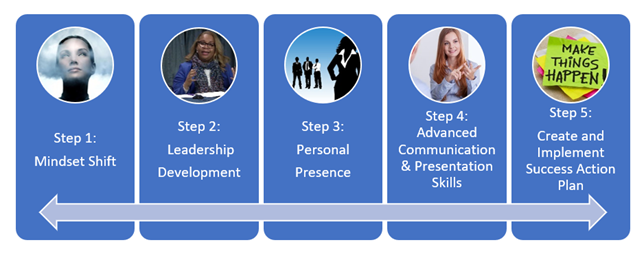

History
In order to own our unique value, we must have a healthy self-worth. Self-worth is an emotional reaction to one’s own self-evaluation. It’s a sense of trust in our own abilities and attributes.
This feeling is so fundamental to our functioning that we’ve given it a variety of names. There’s self-esteem and confidence, as well as self-evaluation and self-appraisal. All of these, however, appear to work in feedback loops that either increase or decrease self-worth.
For better or worse, our early experiences lay the groundwork for our sense of self-worth. The ability to recognize and control emotions is what leads to the affective construct of self-worth, which then leads to the cognitive construct. Our self-worth enable us to make sense of our experiences, believe in our abilities, and develop an authentic identity based on our talents and beliefs.

Current Position
Despite the fact that women have made great progress in the workforce, there is no doubt that they are still finding it difficult to advance up the corporate ladder. Women from low-income backgrounds face enormous challenges to entering and succeeding in the workforce all around the world. They often have fewer job opportunities, higher safety risks, and less political representation than men.
We should celebrate the significant gains women have made in the workforce as we commemorate the centennial of the 19th Amendment, which gave women the right to vote. Over the last century and a quarter, their entry into paid work has been a crucial driver in the world’s prosperity.
We have gained significant benefits from the growing role of women in the economy. However, data suggests that hurdles to women’s continuous advancement still exist. The magnitude of these hurdles should prompt us to consider how structural issues, such as a lack of equal opportunity and difficulties between work and family life, are preventing women from progressing.
Despite this development, it appears that many women are still unable to fulfill their objectives. Although the wage gap between men and women has narrowed in recent years, it remains large; women working full-time still earn roughly 17% less per week than males. Even when we compare men and women in the same or similar occupations with virtually equivalent backgrounds and experience, there is approximately a 10% difference in pay.
Women continue to be underrepresented in many industries and occupations; and too many women struggle to balance work and family obligations.
Barriers to equal opportunity and workplace policies and customs that do not promote a reasonable work-life balance have slowed progress. If these barriers persist, we will waste the potential of many of our female citizens and suffer a significant loss in our economy’s productive capacity at a time when population, aging and low productivity growth are already impacting on economic growth.
According to recent data, even while women currently enroll in professional institutions in approximately equal numbers as men, they are still significantly less likely to reach the top echelons of their fields.

Future Outlook
Continued development would help our workplaces and families, as well as women themselves. However, a number of issues appear to be holding women back, including the difficulty women face in balancing their careers with other elements of their lives, such as child-care. When considering solutions, we should examine changes to work conditions and policies that benefit all workers, not just women. Pursuing such a plan would be consistent with the increase in women’s participation in the workforce, which has benefited not only their own self-worth and well-being but the welfare and prosperity of our society as a whole.
With the right support, many women have been able to change their destiny by taking control of their futures by being courageous enough to follow their dreams. This requires them to do the work. Which is to transform their belief system and to get clear on what makes them unique and how they can use those unique gifts to be fulfilled in their lives and careers and make an impact.
Empowering the next generation to be better leaders and citizens of society is more vital than ever, from mentorship and advocacy to resources and investment. The concerns raised by the epidemic aren’t going away anytime soon, which is why it’s critical that we provide our future women leaders with the tools they need to effect constructive social change and avoid repeating the mistakes of previous generations. The future has already arrived, and now is the moment to invest in it.
In today’s business climate, it’s critical for companies to have a procedure that explicitly promotes and empowers women. Especially when it comes to helping them understand their unique value. Only a proven system that guarantees all women have access to what they need to succeed can bring about change in this area. As a result, company culture, employee retention, productivity, and profitability will all benefit.
Executive Summary

The first workshop in our Women Empowerment Program – Unique Value; focuses on Identifying and Owning Your Unique Value, So You Can Present Yourself with Confidence and Make a Bigger Impact.
Although women today have made many strides in their personal development, many women professionals still do not fully understand their own unique value, so they don’t have the confidence to present themselves powerfully or ask for what they want. There is so much opportunity available to better support women in the workplace. During this workshop, we will reveal what we can do to start believing in ourselves, ignite our passion, shift our mindset of what’s possible, visualize our dreams, discover the power of investing in ourselves, reveal our unique gifts and the value we offer and learn how to stand in our power as a leader. This allows us to work in our brilliance, effectively articulate our value and make a bigger impact as a leader.

There are 12 courses (or focus areas) in the Unique Value Workshop.
Here are the areas we will cover:
1. Believe Yourself – Did you know that our value is directly related to our belief in ourselves? We can’t value ourselves unless we first believe in ourselves. This implies that we must believe the following: – You are a gifted and talented individual, you are passionate about your work, you have clear objectives and goals, you can execute your plan and achieve results, you have the ability to accomplish something extraordinary — or even impossible.
Our potential holds our value.
We’ll never appreciate our potential if we treat ourselves like garbage. Our genuine worth and value is found in our potential. We won’t be able to determine our worth unless we know what we’re capable of. Our potential is intangible, and a large part of it is determined by our attitude. If we have a keen thinking and are disciplined, we will achieve incredible results and most likely exceed our potential. It’s not where we are right now that decides our worth, but where we’re going.
Knowing our value is useless if we don’t know how to express it. We must confidently communicate our value in a respectful manner and leave our ego out of the equation.
“Instead of ego, believe in yourself and that you are enough.”
Knowing your genuine value will benefit you in all facets of your life and career. It will sharpen your decision-making skills and enable you to identify the ideas, people, and issues with which you should align yourself. In this course you will learn 5 key beliefs to adopt to start believing in yourself.

2. Ignite Passion – Are you feeling stuck or living your life on auto pilot? The truth is, that is a choice -we can choose to live a sub-standard life, or we can choose to live a life full of passion. We are all unique, we have our own set of God-given talents, skills, education, and experiences. When we start getting clear on what our gifts are and what we’re passionate about- this is when the magic happens- this is when we can discover our brilliance. People who create the life of their dreams and live their passion typically have these things in common: they’re following a burning desire that no longer allows them to ignore their passion, and they’re 100 percent committed to making significant changes and starting to take responsibility for their actions and their results.
When we align our career around our gifts/passion we will not only be passionate about what we do, but our co-workers, teammates, and customers will be attracted to us and our passion, we’ll also be able to live a fulfilled and joyful life. In order, for us to ignite this passion, we must get clear on what we truly want. Discover how to ignite our passion with the Ignite Your Passion Process.

3. What’s Possible – What’s possible for you, your resilience, your leadership, your work culture? We can change the game of life by focusing on the solution or what is possible versus the problem. The great news is that we always have a choice to make – we can create our own destiny. In this course, we will learn how to turn our goals and dreams into a reality with the Go For It Formula.
We will also develop our Performance Management. As part of performance management, it’s usual to work with a manager to build a career plan. This allows an employee or manager to discuss their aims with their boss or management and receive suggestions on how to achieve their objectives.

4. Mindset Shift – The #1 belief that holds people back is “I’m not ready.” We have a way of producing all the reasons why we can’t accomplish something versus taking action on our goals What we see as possible, determines our success. If we see an opportunity, then we are ready. It is important to always expand our possibilities since possibilities create opportunity.
The focus of this lesson is on changing our thinking. When we transform our mindset, we can transform our results. Together, we will assess our self-worth and how it directly impacts our net-worth and we will learn my 5 Easy Steps to increase your Self-Worth. We will also go through my 7 Mindsets to Adopt, so you can transform your life.

5. Building Confidence – People that are self-confident appear to be at ease with themselves and their work. They invite others to trust them and instill confidence in them. These are all desirable qualities to possess. But being confident in ourselves isn’t always simple, especially if we’re naturally self-critical or if others put us down. There are, thankfully, steps we can take to boost and maintain our self-confidence which we will cover in this course.
There is a distinct difference between those who drive towards their goals and get what they want in life and those who can’t. We will uncover the difference. We will discover what it looks like to have confidence in the workplace, confidence in communication, how we can boost our productivity and expand our knowledge. We will also gain access to the 5 Tips to help build your confidence.

6. Visualize Dreams – Visualization is a powerful tool to assist you in reaching your goals. The Law of Attraction and the power of vision go hand in hand. The concept is to envision an image in your mind that will be drawn to you if you visualize it often enough. You probably already do this without even realizing it! When you focus on what could go wrong, things tend to go wrong, reinforcing the inclination to focus on what could go wrong… because it has in the past! You may, however, harness that great creative ability for your own gain. In this lesson, we will show you a proven method how. We will explore what visualization is, how to visualize and how visualization can transform our lives.
We also will go through the Law of Attraction and how we can use it as a powerful tool to attract what we want. Finally, we will go through the 6 Ways to Help You Visualize Success.

7. Investing in Yourself – Investing in ourselves is the best return on investment we can have. Whether it’s building our career, learning a new skill, working on our creativity or personal development; we need to give to ourselves first before we can give to others.
So, it’s not always money that’s required, when investing in oneself, time and energy are just as important. Investing in yourself, requires learning how to maximize the unlimited potential that lies within your mind and body.
Why is investing in yourself so powerful?
Investing in yourself sends a powerful message to yourself and the world. The message is: The value and potential that I possess, is important enough to me that I’m going to give it the energy, space, and time to grow and create results. In this lesson, you will discover the top 10 ways to invest in yourself.

8. Setting Boundaries -Setting boundaries is essential to maintain our happiness and to be fulfilled in our life. In this lesson, we will identify our priorities and learn how to align with your values. We will also go through a process of how we can set up firm boundaries so we can thrive in our work environment. Finally, we will learn time management skills so we can effectively manage our time leading to massive productivity.

9. Reveal Value – Our unique value is made up of many things- our unique God-given talents, our skills, our education, and our experiences. So, in this case, there is no one else like us. We are each amazing and unique. Co-workers will want to work with us because of who we are and what you bring to the table that is different than everyone else. That is why there is truly no such thing as competition, especially if we build our career based on our unique gifts/passion. In this lesson, we will reveal our unique value with a proven powerful method that will transform how we value ourselves and how we articulate what we do allowing you to raise our confidence exponentially.

10. Adopting Value – Now that we’re clear on our unique value, it is important to know how to best utilize our unique value and adopt it in the workplace. In this lesson, we will explore our past experiences that allowed us to use our gifts. We will also address key areas such as Role on a Team, Key indicators, Learning Style, Social Orientation, Relationship Patterns, and End Goals and how your unique value can be properly utilized in each area. It’s crucial to keep in mind that our gifts and talents will develop and become more apparent with time and additional life experience will, in most situations, aid in sharpening your awareness of our strengths and talents.

11. Stand Powerfully – When we hear the word “power,” we may think of control over other people, or money, or even forcefully influencing the course of events. That is one dictatorial definition of power, but there is another: the ability to act in an effective manner. There’s the power of speech, for example, or the ability to ask for what we want, or the simple ability to say no to what you don’t want and yes to what you do. So, what does it mean to stand in your power? It implies that you value what is most essential to you. It indicates that you are aware of who you are, what you are capable of, and why you make the choices you do. Nothing can shake the foundation of who we are or rock our boat. In this lesson, you will discover 8 ways that you can confidently stand in your power as a professional capable woman.

12. Your Potential – In this last lesson, we will discover the exact steps to take to live up to our true potential. Many individuals anticipate there will be more obstacles in life and continue on their path with their head down, dreading failure. Or they let one person’s negativity affect their attitude when an unhappy customer takes out his or her aggravation on them. Or they may carry the rejections into their next sales pitch when the “noes” outnumber the “yeses” in sales. If you resonated with any of these statements, you risk not only suffocating your intrinsic potential, but also never discovering who you truly are or what you can become. It’s all too easy to allow life’s difficulties sap our energy, deplete our motivation, and give us a pessimistic attitude, but there is a method to keep challenging situations and negative ideas from getting in the way of your success and pleasure. We can be intentional with our plans moving forward. In this final course of the workshop, you will discover How to Activate Your True Potential in 8 Easy Steps.

Impact for Positive Change
At the conclusion of each workshop, we will focus our collective attention on how you, as a leader, will put what we’ve learned into practice in your company. Impact for positive change not only requires putting what you’ve learned into practice but also taking action to make a significant difference. That starts with a strong desire to change and reflection on what you’re going to do differently. It’s also crucial to consider how you’ll involve people in your organization in the discussion about what you’ve learnt and make requests for what you need from them in order to succeed. Not only will your formal team be involved, but so will your cross-functional colleagues. How would you collaborate to ensure all the women in your company have everything they need to succeed?
Curriculum
Women Empowerment – Workshop 1 – Unique Value
- Believe Yourself
- Ignite Passion
- What’s Possible
- Mindset Shift
- Building Confidence
- Visualize Dreams
- Investing in Yourself
- Setting Boundaries
- Reveal Value
- Adapting Value
- Stand Powerfully
- Your Potential
Distance Learning
Introduction
Welcome to Appleton Greene and thank you for enrolling on the Women Empowerment corporate training program. You will be learning through our unique facilitation via distance-learning method, which will enable you to practically implement everything that you learn academically. The methods and materials used in your program have been designed and developed to ensure that you derive the maximum benefits and enjoyment possible. We hope that you find the program challenging and fun to do. However, if you have never been a distance-learner before, you may be experiencing some trepidation at the task before you. So we will get you started by giving you some basic information and guidance on how you can make the best use of the modules, how you should manage the materials and what you should be doing as you work through them. This guide is designed to point you in the right direction and help you to become an effective distance-learner. Take a few hours or so to study this guide and your guide to tutorial support for students, while making notes, before you start to study in earnest.
Study environment
You will need to locate a quiet and private place to study, preferably a room where you can easily be isolated from external disturbances or distractions. Make sure the room is well-lit and incorporates a relaxed, pleasant feel. If you can spoil yourself within your study environment, you will have much more of a chance to ensure that you are always in the right frame of mind when you do devote time to study. For example, a nice fire, the ability to play soft soothing background music, soft but effective lighting, perhaps a nice view if possible and a good size desk with a comfortable chair. Make sure that your family know when you are studying and understand your study rules. Your study environment is very important. The ideal situation, if at all possible, is to have a separate study, which can be devoted to you. If this is not possible then you will need to pay a lot more attention to developing and managing your study schedule, because it will affect other people as well as yourself. The better your study environment, the more productive you will be.
Study tools & rules
Try and make sure that your study tools are sufficient and in good working order. You will need to have access to a computer, scanner and printer, with access to the internet. You will need a very comfortable chair, which supports your lower back, and you will need a good filing system. It can be very frustrating if you are spending valuable study time trying to fix study tools that are unreliable, or unsuitable for the task. Make sure that your study tools are up to date. You will also need to consider some study rules. Some of these rules will apply to you and will be intended to help you to be more disciplined about when and how you study. This distance-learning guide will help you and after you have read it you can put some thought into what your study rules should be. You will also need to negotiate some study rules for your family, friends or anyone who lives with you. They too will need to be disciplined in order to ensure that they can support you while you study. It is important to ensure that your family and friends are an integral part of your study team. Having their support and encouragement can prove to be a crucial contribution to your successful completion of the program. Involve them in as much as you can.
Successful distance-learning
Distance-learners are freed from the necessity of attending regular classes or workshops, since they can study in their own way, at their own pace and for their own purposes. But unlike traditional internal training courses, it is the student’s responsibility, with a distance-learning program, to ensure that they manage their own study contribution. This requires strong self-discipline and self-motivation skills and there must be a clear will to succeed. Those students who are used to managing themselves, are good at managing others and who enjoy working in isolation, are more likely to be good distance-learners. It is also important to be aware of the main reasons why you are studying and of the main objectives that you are hoping to achieve as a result. You will need to remind yourself of these objectives at times when you need to motivate yourself. Never lose sight of your long-term goals and your short-term objectives. There is nobody available here to pamper you, or to look after you, or to spoon-feed you with information, so you will need to find ways to encourage and appreciate yourself while you are studying. Make sure that you chart your study progress, so that you can be sure of your achievements and re-evaluate your goals and objectives regularly.
Self-assessment
Appleton Greene training programs are in all cases post-graduate programs. Consequently, you should already have obtained a business-related degree and be an experienced learner. You should therefore already be aware of your study strengths and weaknesses. For example, which time of the day are you at your most productive? Are you a lark or an owl? What study methods do you respond to the most? Are you a consistent learner? How do you discipline yourself? How do you ensure that you enjoy yourself while studying? It is important to understand yourself as a learner and so some self-assessment early on will be necessary if you are to apply yourself correctly. Perform a SWOT analysis on yourself as a student. List your internal strengths and weaknesses as a student and your external opportunities and threats. This will help you later on when you are creating a study plan. You can then incorporate features within your study plan that can ensure that you are playing to your strengths, while compensating for your weaknesses. You can also ensure that you make the most of your opportunities, while avoiding the potential threats to your success.
Accepting responsibility as a student
Training programs invariably require a significant investment, both in terms of what they cost and in the time that you need to contribute to study and the responsibility for successful completion of training programs rests entirely with the student. This is never more apparent than when a student is learning via distance-learning. Accepting responsibility as a student is an important step towards ensuring that you can successfully complete your training program. It is easy to instantly blame other people or factors when things go wrong. But the fact of the matter is that if a failure is your failure, then you have the power to do something about it, it is entirely in your own hands. If it is always someone else’s failure, then you are powerless to do anything about it. All students study in entirely different ways, this is because we are all individuals and what is right for one student, is not necessarily right for another. In order to succeed, you will have to accept personal responsibility for finding a way to plan, implement and manage a personal study plan that works for you. If you do not succeed, you only have yourself to blame.
Planning
By far the most critical contribution to stress, is the feeling of not being in control. In the absence of planning we tend to be reactive and can stumble from pillar to post in the hope that things will turn out fine in the end. Invariably they don’t! In order to be in control, we need to have firm ideas about how and when we want to do things. We also need to consider as many possible eventualities as we can, so that we are prepared for them when they happen. Prescriptive Change, is far easier to manage and control, than Emergent Change. The same is true with distance-learning. It is much easier and much more enjoyable, if you feel that you are in control and that things are going to plan. Even when things do go wrong, you are prepared for them and can act accordingly without any unnecessary stress. It is important therefore that you do take time to plan your studies properly.
Management
Once you have developed a clear study plan, it is of equal importance to ensure that you manage the implementation of it. Most of us usually enjoy planning, but it is usually during implementation when things go wrong. Targets are not met and we do not understand why. Sometimes we do not even know if targets are being met. It is not enough for us to conclude that the study plan just failed. If it is failing, you will need to understand what you can do about it. Similarly if your study plan is succeeding, it is still important to understand why, so that you can improve upon your success. You therefore need to have guidelines for self-assessment so that you can be consistent with performance improvement throughout the program. If you manage things correctly, then your performance should constantly improve throughout the program.
Study objectives & tasks
The first place to start is developing your program objectives. These should feature your reasons for undertaking the training program in order of priority. Keep them succinct and to the point in order to avoid confusion. Do not just write the first things that come into your head because they are likely to be too similar to each other. Make a list of possible departmental headings, such as: Customer Service; E-business; Finance; Globalization; Human Resources; Technology; Legal; Management; Marketing and Production. Then brainstorm for ideas by listing as many things that you want to achieve under each heading and later re-arrange these things in order of priority. Finally, select the top item from each department heading and choose these as your program objectives. Try and restrict yourself to five because it will enable you to focus clearly. It is likely that the other things that you listed will be achieved if each of the top objectives are achieved. If this does not prove to be the case, then simply work through the process again.
Study forecast
As a guide, the Appleton Greene Women Empowerment corporate training program should take 12-18 months to complete, depending upon your availability and current commitments. The reason why there is such a variance in time estimates is because every student is an individual, with differing productivity levels and different commitments. These differentiations are then exaggerated by the fact that this is a distance-learning program, which incorporates the practical integration of academic theory as an as a part of the training program. Consequently all of the project studies are real, which means that important decisions and compromises need to be made. You will want to get things right and will need to be patient with your expectations in order to ensure that they are. We would always recommend that you are prudent with your own task and time forecasts, but you still need to develop them and have a clear indication of what are realistic expectations in your case. With reference to your time planning: consider the time that you can realistically dedicate towards study with the program every week; calculate how long it should take you to complete the program, using the guidelines featured here; then break the program down into logical modules and allocate a suitable proportion of time to each of them, these will be your milestones; you can create a time plan by using a spreadsheet on your computer, or a personal organizer such as MS Outlook, you could also use a financial forecasting software; break your time forecasts down into manageable chunks of time, the more specific you can be, the more productive and accurate your time management will be; finally, use formulas where possible to do your time calculations for you, because this will help later on when your forecasts need to change in line with actual performance. With reference to your task planning: refer to your list of tasks that need to be undertaken in order to achieve your program objectives; with reference to your time plan, calculate when each task should be implemented; remember that you are not estimating when your objectives will be achieved, but when you will need to focus upon implementing the corresponding tasks; you also need to ensure that each task is implemented in conjunction with the associated training modules which are relevant; then break each single task down into a list of specific to do’s, say approximately ten to do’s for each task and enter these into your study plan; once again you could use MS Outlook to incorporate both your time and task planning and this could constitute your study plan; you could also use a project management software like MS Project. You should now have a clear and realistic forecast detailing when you can expect to be able to do something about undertaking the tasks to achieve your program objectives.
Performance management
It is one thing to develop your study forecast, it is quite another to monitor your progress. Ultimately it is less important whether you achieve your original study forecast and more important that you update it so that it constantly remains realistic in line with your performance. As you begin to work through the program, you will begin to have more of an idea about your own personal performance and productivity levels as a distance-learner. Once you have completed your first study module, you should re-evaluate your study forecast for both time and tasks, so that they reflect your actual performance level achieved. In order to achieve this you must first time yourself while training by using an alarm clock. Set the alarm for hourly intervals and make a note of how far you have come within that time. You can then make a note of your actual performance on your study plan and then compare your performance against your forecast. Then consider the reasons that have contributed towards your performance level, whether they are positive or negative and make a considered adjustment to your future forecasts as a result. Given time, you should start achieving your forecasts regularly.
With reference to time management: time yourself while you are studying and make a note of the actual time taken in your study plan; consider your successes with time-efficiency and the reasons for the success in each case and take this into consideration when reviewing future time planning; consider your failures with time-efficiency and the reasons for the failures in each case and take this into consideration when reviewing future time planning; re-evaluate your study forecast in relation to time planning for the remainder of your training program to ensure that you continue to be realistic about your time expectations. You need to be consistent with your time management, otherwise you will never complete your studies. This will either be because you are not contributing enough time to your studies, or you will become less efficient with the time that you do allocate to your studies. Remember, if you are not in control of your studies, they can just become yet another cause of stress for you.
With reference to your task management: time yourself while you are studying and make a note of the actual tasks that you have undertaken in your study plan; consider your successes with task-efficiency and the reasons for the success in each case; take this into consideration when reviewing future task planning; consider your failures with task-efficiency and the reasons for the failures in each case and take this into consideration when reviewing future task planning; re-evaluate your study forecast in relation to task planning for the remainder of your training program to ensure that you continue to be realistic about your task expectations. You need to be consistent with your task management, otherwise you will never know whether you are achieving your program objectives or not.
Keeping in touch
You will have access to qualified and experienced professors and tutors who are responsible for providing tutorial support for your particular training program. So don’t be shy about letting them know how you are getting on. We keep electronic records of all tutorial support emails so that professors and tutors can review previous correspondence before considering an individual response. It also means that there is a record of all communications between you and your professors and tutors and this helps to avoid any unnecessary duplication, misunderstanding, or misinterpretation. If you have a problem relating to the program, share it with them via email. It is likely that they have come across the same problem before and are usually able to make helpful suggestions and steer you in the right direction. To learn more about when and how to use tutorial support, please refer to the Tutorial Support section of this student information guide. This will help you to ensure that you are making the most of tutorial support that is available to you and will ultimately contribute towards your success and enjoyment with your training program.
Work colleagues and family
You should certainly discuss your program study progress with your colleagues, friends and your family. Appleton Greene training programs are very practical. They require you to seek information from other people, to plan, develop and implement processes with other people and to achieve feedback from other people in relation to viability and productivity. You will therefore have plenty of opportunities to test your ideas and enlist the views of others. People tend to be sympathetic towards distance-learners, so don’t bottle it all up in yourself. Get out there and share it! It is also likely that your family and colleagues are going to benefit from your labors with the program, so they are likely to be much more interested in being involved than you might think. Be bold about delegating work to those who might benefit themselves. This is a great way to achieve understanding and commitment from people who you may later rely upon for process implementation. Share your experiences with your friends and family.
Making it relevant
The key to successful learning is to make it relevant to your own individual circumstances. At all times you should be trying to make bridges between the content of the program and your own situation. Whether you achieve this through quiet reflection or through interactive discussion with your colleagues, client partners or your family, remember that it is the most important and rewarding aspect of translating your studies into real self-improvement. You should be clear about how you want the program to benefit you. This involves setting clear study objectives in relation to the content of the course in terms of understanding, concepts, completing research or reviewing activities and relating the content of the modules to your own situation. Your objectives may understandably change as you work through the program, in which case you should enter the revised objectives on your study plan so that you have a permanent reminder of what you are trying to achieve, when and why.
Distance-learning check-list
Prepare your study environment, your study tools and rules.
Undertake detailed self-assessment in terms of your ability as a learner.
Create a format for your study plan.
Consider your study objectives and tasks.
Create a study forecast.
Assess your study performance.
Re-evaluate your study forecast.
Be consistent when managing your study plan.
Use your Appleton Greene Certified Learning Provider (CLP) for tutorial support.
Make sure you keep in touch with those around you.

Tutorial Support
Programs
Appleton Greene uses standard and bespoke corporate training programs as vessels to transfer business process improvement knowledge into the heart of our clients’ organizations. Each individual program focuses upon the implementation of a specific business process, which enables clients to easily quantify their return on investment. There are hundreds of established Appleton Greene corporate training products now available to clients within customer services, e-business, finance, globalization, human resources, information technology, legal, management, marketing and production. It does not matter whether a client’s employees are located within one office, or an unlimited number of international offices, we can still bring them together to learn and implement specific business processes collectively. Our approach to global localization enables us to provide clients with a truly international service with that all important personal touch. Appleton Greene corporate training programs can be provided virtually or locally and they are all unique in that they individually focus upon a specific business function. They are implemented over a sustainable period of time and professional support is consistently provided by qualified learning providers and specialist consultants.
Support available
You will have a designated Certified Learning Provider (CLP) and an Accredited Consultant and we encourage you to communicate with them as much as possible. In all cases tutorial support is provided online because we can then keep a record of all communications to ensure that tutorial support remains consistent. You would also be forwarding your work to the tutorial support unit for evaluation and assessment. You will receive individual feedback on all of the work that you undertake on a one-to-one basis, together with specific recommendations for anything that may need to be changed in order to achieve a pass with merit or a pass with distinction and you then have as many opportunities as you may need to re-submit project studies until they meet with the required standard. Consequently the only reason that you should really fail (CLP) is if you do not do the work. It makes no difference to us whether a student takes 12 months or 18 months to complete the program, what matters is that in all cases the same quality standard will have been achieved.
Support Process
Please forward all of your future emails to the designated (CLP) Tutorial Support Unit email address that has been provided and please do not duplicate or copy your emails to other AGC email accounts as this will just cause unnecessary administration. Please note that emails are always answered as quickly as possible but you will need to allow a period of up to 20 business days for responses to general tutorial support emails during busy periods, because emails are answered strictly within the order in which they are received. You will also need to allow a period of up to 30 business days for the evaluation and assessment of project studies. This does not include weekends or public holidays. Please therefore kindly allow for this within your time planning. All communications are managed online via email because it enables tutorial service support managers to review other communications which have been received before responding and it ensures that there is a copy of all communications retained on file for future reference. All communications will be stored within your personal (CLP) study file here at Appleton Greene throughout your designated study period. If you need any assistance or clarification at any time, please do not hesitate to contact us by forwarding an email and remember that we are here to help. If you have any questions, please list and number your questions succinctly and you can then be sure of receiving specific answers to each and every query.
Time Management
It takes approximately 1 Year to complete the Women Empowerment corporate training program, incorporating 12 x 6-hour monthly workshops. Each student will also need to contribute approximately 4 hours per week over 1 Year of their personal time. Students can study from home or work at their own pace and are responsible for managing their own study plan. There are no formal examinations and students are evaluated and assessed based upon their project study submissions, together with the quality of their internal analysis and supporting documents. They can contribute more time towards study when they have the time to do so and can contribute less time when they are busy. All students tend to be in full time employment while studying and the Women Empowerment program is purposely designed to accommodate this, so there is plenty of flexibility in terms of time management. It makes no difference to us at Appleton Greene, whether individuals take 12-18 months to complete this program. What matters is that in all cases the same standard of quality will have been achieved with the standard and bespoke programs that have been developed.
Distance Learning Guide
The distance learning guide should be your first port of call when starting your training program. It will help you when you are planning how and when to study, how to create the right environment and how to establish the right frame of mind. If you can lay the foundations properly during the planning stage, then it will contribute to your enjoyment and productivity while training later. The guide helps to change your lifestyle in order to accommodate time for study and to cultivate good study habits. It helps you to chart your progress so that you can measure your performance and achieve your goals. It explains the tools that you will need for study and how to make them work. It also explains how to translate academic theory into practical reality. Spend some time now working through your distance learning guide and make sure that you have firm foundations in place so that you can make the most of your distance learning program. There is no requirement for you to attend training workshops or classes at Appleton Greene offices. The entire program is undertaken online, program course manuals and project studies are administered via the Appleton Greene web site and via email, so you are able to study at your own pace and in the comfort of your own home or office as long as you have a computer and access to the internet.
How To Study
The how to study guide provides students with a clear understanding of the Appleton Greene facilitation via distance learning training methods and enables students to obtain a clear overview of the training program content. It enables students to understand the step-by-step training methods used by Appleton Greene and how course manuals are integrated with project studies. It explains the research and development that is required and the need to provide evidence and references to support your statements. It also enables students to understand precisely what will be required of them in order to achieve a pass with merit and a pass with distinction for individual project studies and provides useful guidance on how to be innovative and creative when developing your Unique Program Proposition (UPP).
Tutorial Support
Tutorial support for the Appleton Greene Women Empowerment corporate training program is provided online either through the Appleton Greene Client Support Portal (CSP), or via email. All tutorial support requests are facilitated by a designated Program Administration Manager (PAM). They are responsible for deciding which professor or tutor is the most appropriate option relating to the support required and then the tutorial support request is forwarded onto them. Once the professor or tutor has completed the tutorial support request and answered any questions that have been asked, this communication is then returned to the student via email by the designated Program Administration Manager (PAM). This enables all tutorial support, between students, professors and tutors, to be facilitated by the designated Program Administration Manager (PAM) efficiently and securely through the email account. You will therefore need to allow a period of up to 20 business days for responses to general support queries and up to 30 business days for the evaluation and assessment of project studies, because all tutorial support requests are answered strictly within the order in which they are received. This does not include weekends or public holidays. Consequently you need to put some thought into the management of your tutorial support procedure in order to ensure that your study plan is feasible and to obtain the maximum possible benefit from tutorial support during your period of study. Please retain copies of your tutorial support emails for future reference. Please ensure that ALL of your tutorial support emails are set out using the format as suggested within your guide to tutorial support. Your tutorial support emails need to be referenced clearly to the specific part of the course manual or project study which you are working on at any given time. You also need to list and number any questions that you would like to ask, up to a maximum of five questions within each tutorial support email. Remember the more specific you can be with your questions the more specific your answers will be too and this will help you to avoid any unnecessary misunderstanding, misinterpretation, or duplication. The guide to tutorial support is intended to help you to understand how and when to use support in order to ensure that you get the most out of your training program. Appleton Greene training programs are designed to enable you to do things for yourself. They provide you with a structure or a framework and we use tutorial support to facilitate students while they practically implement what they learn. In other words, we are enabling students to do things for themselves. The benefits of distance learning via facilitation are considerable and are much more sustainable in the long-term than traditional short-term knowledge sharing programs. Consequently you should learn how and when to use tutorial support so that you can maximize the benefits from your learning experience with Appleton Greene. This guide describes the purpose of each training function and how to use them and how to use tutorial support in relation to each aspect of the training program. It also provides useful tips and guidance with regard to best practice.
Tutorial Support Tips
Students are often unsure about how and when to use tutorial support with Appleton Greene. This Tip List will help you to understand more about how to achieve the most from using tutorial support. Refer to it regularly to ensure that you are continuing to use the service properly. Tutorial support is critical to the success of your training experience, but it is important to understand when and how to use it in order to maximize the benefit that you receive. It is no coincidence that those students who succeed are those that learn how to be positive, proactive and productive when using tutorial support.
Be positive and friendly with your tutorial support emails
Remember that if you forward an email to the tutorial support unit, you are dealing with real people. “Do unto others as you would expect others to do unto you”. If you are positive, complimentary and generally friendly in your emails, you will generate a similar response in return. This will be more enjoyable, productive and rewarding for you in the long-term.
Think about the impression that you want to create
Every time that you communicate, you create an impression, which can be either positive or negative, so put some thought into the impression that you want to create. Remember that copies of all tutorial support emails are stored electronically and tutors will always refer to prior correspondence before responding to any current emails. Over a period of time, a general opinion will be arrived at in relation to your character, attitude and ability. Try to manage your own frustrations, mood swings and temperament professionally, without involving the tutorial support team. Demonstrating frustration or a lack of patience is a weakness and will be interpreted as such. The good thing about communicating in writing, is that you will have the time to consider your content carefully, you can review it and proof-read it before sending your email to Appleton Greene and this should help you to communicate more professionally, consistently and to avoid any unnecessary knee-jerk reactions to individual situations as and when they may arise. Please also remember that the CLP Tutorial Support Unit will not just be responsible for evaluating and assessing the quality of your work, they will also be responsible for providing recommendations to other learning providers and to client contacts within the Appleton Greene global client network, so do be in control of your own emotions and try to create a good impression.
Remember that quality is preferred to quantity
Please remember that when you send an email to the tutorial support team, you are not using Twitter or Text Messaging. Try not to forward an email every time that you have a thought. This will not prove to be productive either for you or for the tutorial support team. Take time to prepare your communications properly, as if you were writing a professional letter to a business colleague and make a list of queries that you are likely to have and then incorporate them within one email, say once every month, so that the tutorial support team can understand more about context, application and your methodology for study. Get yourself into a consistent routine with your tutorial support requests and use the tutorial support template provided with ALL of your emails. The (CLP) Tutorial Support Unit will not spoon-feed you with information. They need to be able to evaluate and assess your tutorial support requests carefully and professionally.
Be specific about your questions in order to receive specific answers
Try not to write essays by thinking as you are writing tutorial support emails. The tutorial support unit can be unclear about what in fact you are asking, or what you are looking to achieve. Be specific about asking questions that you want answers to. Number your questions. You will then receive specific answers to each and every question. This is the main purpose of tutorial support via email.
Keep a record of your tutorial support emails
It is important that you keep a record of all tutorial support emails that are forwarded to you. You can then refer to them when necessary and it avoids any unnecessary duplication, misunderstanding, or misinterpretation.
Individual training workshops or telephone support
Please be advised that Appleton Greene does not provide separate or individual tutorial support meetings, workshops, or provide telephone support for individual students. Appleton Greene is an equal opportunities learning and service provider and we are therefore understandably bound to treat all students equally. We cannot therefore broker special financial or study arrangements with individual students regardless of the circumstances. All tutorial support is provided online and this enables Appleton Greene to keep a record of all communications between students, professors and tutors on file for future reference, in accordance with our quality management procedure and your terms and conditions of enrolment. All tutorial support is provided online via email because it enables us to have time to consider support content carefully, it ensures that you receive a considered and detailed response to your queries. You can number questions that you would like to ask, which relate to things that you do not understand or where clarification may be required. You can then be sure of receiving specific answers to each individual query. You will also then have a record of these communications and of all tutorial support, which has been provided to you. This makes tutorial support administration more productive by avoiding any unnecessary duplication, misunderstanding, or misinterpretation.
Tutorial Support Email Format
You should use this tutorial support format if you need to request clarification or assistance while studying with your training program. Please note that ALL of your tutorial support request emails should use the same format. You should therefore set up a standard email template, which you can then use as and when you need to. Emails that are forwarded to Appleton Greene, which do not use the following format, may be rejected and returned to you by the (CLP) Program Administration Manager. A detailed response will then be forwarded to you via email usually within 20 business days of receipt for general support queries and 30 business days for the evaluation and assessment of project studies. This does not include weekends or public holidays. Your tutorial support request, together with the corresponding TSU reply, will then be saved and stored within your electronic TSU file at Appleton Greene for future reference.
Subject line of your email
Please insert: Appleton Greene (CLP) Tutorial Support Request: (Your Full Name) (Date), within the subject line of your email.
Main body of your email
Please insert:
1. Appleton Greene Certified Learning Provider (CLP) Tutorial Support Request
2. Your Full Name
3. Date of TS request
4. Preferred email address
5. Backup email address
6. Course manual page name or number (reference)
7. Project study page name or number (reference)
Subject of enquiry
Please insert a maximum of 50 words (please be succinct)
Briefly outline the subject matter of your inquiry, or what your questions relate to.
Question 1
Maximum of 50 words (please be succinct)
Maximum of 50 words (please be succinct)
Question 3
Maximum of 50 words (please be succinct)
Question 4
Maximum of 50 words (please be succinct)
Question 5
Maximum of 50 words (please be succinct)
Please note that a maximum of 5 questions is permitted with each individual tutorial support request email.
Procedure
* List the questions that you want to ask first, then re-arrange them in order of priority. Make sure that you reference them, where necessary, to the course manuals or project studies.
* Make sure that you are specific about your questions and number them. Try to plan the content within your emails to make sure that it is relevant.
* Make sure that your tutorial support emails are set out correctly, using the Tutorial Support Email Format provided here.
* Save a copy of your email and incorporate the date sent after the subject title. Keep your tutorial support emails within the same file and in date order for easy reference.
* Allow up to 20 business days for a response to general tutorial support emails and up to 30 business days for the evaluation and assessment of project studies, because detailed individual responses will be made in all cases and tutorial support emails are answered strictly within the order in which they are received.
* Emails can and do get lost. So if you have not received a reply within the appropriate time, forward another copy or a reminder to the tutorial support unit to be sure that it has been received but do not forward reminders unless the appropriate time has elapsed.
* When you receive a reply, save it immediately featuring the date of receipt after the subject heading for easy reference. In most cases the tutorial support unit replies to your questions individually, so you will have a record of the questions that you asked as well as the answers offered. With project studies however, separate emails are usually forwarded by the tutorial support unit, so do keep a record of your own original emails as well.
* Remember to be positive and friendly in your emails. You are dealing with real people who will respond to the same things that you respond to.
* Try not to repeat questions that have already been asked in previous emails. If this happens the tutorial support unit will probably just refer you to the appropriate answers that have already been provided within previous emails.
* If you lose your tutorial support email records you can write to Appleton Greene to receive a copy of your tutorial support file, but a separate administration charge may be levied for this service.

How To Study
Your Certified Learning Provider (CLP) and Accredited Consultant can help you to plan a task list for getting started so that you can be clear about your direction and your priorities in relation to your training program. It is also a good way to introduce yourself to the tutorial support team.
Planning your study environment
Your study conditions are of great importance and will have a direct effect on how much you enjoy your training program. Consider how much space you will have, whether it is comfortable and private and whether you are likely to be disturbed. The study tools and facilities at your disposal are also important to the success of your distance-learning experience. Your tutorial support unit can help with useful tips and guidance, regardless of your starting position. It is important to get this right before you start working on your training program.
Planning your program objectives
It is important that you have a clear list of study objectives, in order of priority, before you start working on your training program. Your tutorial support unit can offer assistance here to ensure that your study objectives have been afforded due consideration and priority.
Planning how and when to study
Distance-learners are freed from the necessity of attending regular classes, since they can study in their own way, at their own pace and for their own purposes. This approach is designed to let you study efficiently away from the traditional classroom environment. It is important however, that you plan how and when to study, so that you are making the most of your natural attributes, strengths and opportunities. Your tutorial support unit can offer assistance and useful tips to ensure that you are playing to your strengths.
Planning your study tasks
You should have a clear understanding of the study tasks that you should be undertaking and the priority associated with each task. These tasks should also be integrated with your program objectives. The distance learning guide and the guide to tutorial support for students should help you here, but if you need any clarification or assistance, please contact your tutorial support unit.
Planning your time
You will need to allocate specific times during your calendar when you intend to study if you are to have a realistic chance of completing your program on time. You are responsible for planning and managing your own study time, so it is important that you are successful with this. Your tutorial support unit can help you with this if your time plan is not working.
Keeping in touch
Consistency is the key here. If you communicate too frequently in short bursts, or too infrequently with no pattern, then your management ability with your studies will be questioned, both by you and by your tutorial support unit. It is obvious when a student is in control and when one is not and this will depend how able you are at sticking with your study plan. Inconsistency invariably leads to in-completion.
Charting your progress
Your tutorial support team can help you to chart your own study progress. Refer to your distance learning guide for further details.
Making it work
To succeed, all that you will need to do is apply yourself to undertaking your training program and interpreting it correctly. Success or failure lies in your hands and your hands alone, so be sure that you have a strategy for making it work. Your Certified Learning Provider (CLP) and Accredited Consultant can guide you through the process of program planning, development and implementation.
Reading methods
Interpretation is often unique to the individual but it can be improved and even quantified by implementing consistent interpretation methods. Interpretation can be affected by outside interference such as family members, TV, or the Internet, or simply by other thoughts which are demanding priority in our minds. One thing that can improve our productivity is using recognized reading methods. This helps us to focus and to be more structured when reading information for reasons of importance, rather than relaxation.
Speed reading
When reading through course manuals for the first time, subconsciously set your reading speed to be just fast enough that you cannot dwell on individual words or tables. With practice, you should be able to read an A4 sheet of paper in one minute. You will not achieve much in the way of a detailed understanding, but your brain will retain a useful overview. This overview will be important later on and will enable you to keep individual issues in perspective with a more generic picture because speed reading appeals to the memory part of the brain. Do not worry about what you do or do not remember at this stage.
Content reading
Once you have speed read everything, you can then start work in earnest. You now need to read a particular section of your course manual thoroughly, by making detailed notes while you read. This process is called Content Reading and it will help to consolidate your understanding and interpretation of the information that has been provided.
Making structured notes on the course manuals
When you are content reading, you should be making detailed notes, which are both structured and informative. Make these notes in a MS Word document on your computer, because you can then amend and update these as and when you deem it to be necessary. List your notes under three headings: 1. Interpretation – 2. Questions – 3. Tasks. The purpose of the 1st section is to clarify your interpretation by writing it down. The purpose of the 2nd section is to list any questions that the issue raises for you. The purpose of the 3rd section is to list any tasks that you should undertake as a result. Anyone who has graduated with a business-related degree should already be familiar with this process.
Organizing structured notes separately
You should then transfer your notes to a separate study notebook, preferably one that enables easy referencing, such as a MS Word Document, a MS Excel Spreadsheet, a MS Access Database, or a personal organizer on your cell phone. Transferring your notes allows you to have the opportunity of cross-checking and verifying them, which assists considerably with understanding and interpretation. You will also find that the better you are at doing this, the more chance you will have of ensuring that you achieve your study objectives.
Question your understanding
Do challenge your understanding. Explain things to yourself in your own words by writing things down.
Clarifying your understanding
If you are at all unsure, forward an email to your tutorial support unit and they will help to clarify your understanding.
Question your interpretation
Do challenge your interpretation. Qualify your interpretation by writing it down.
Clarifying your interpretation
If you are at all unsure, forward an email to your tutorial support unit and they will help to clarify your interpretation.
Qualification Requirements
The student will need to successfully complete the project study and all of the exercises relating to the Women Empowerment corporate training program, achieving a pass with merit or distinction in each case, in order to qualify as an Accredited Women Empowerment Specialist (AWES). All monthly workshops need to be tried and tested within your company. These project studies can be completed in your own time and at your own pace and in the comfort of your own home or office. There are no formal examinations, assessment is based upon the successful completion of the project studies. They are called project studies because, unlike case studies, these projects are not theoretical, they incorporate real program processes that need to be properly researched and developed. The project studies assist us in measuring your understanding and interpretation of the training program and enable us to assess qualification merits. All of the project studies are based entirely upon the content within the training program and they enable you to integrate what you have learnt into your corporate training practice.
Women Empowerment – Grading Contribution
Project Study – Grading Contribution
Customer Service – 10%
E-business – 05%
Finance – 10%
Globalization – 10%
Human Resources – 10%
Information Technology – 10%
Legal – 05%
Management – 10%
Marketing – 10%
Production – 10%
Education – 05%
Logistics – 05%
TOTAL GRADING – 100%
Qualification grades
A mark of 90% = Pass with Distinction.
A mark of 75% = Pass with Merit.
A mark of less than 75% = Fail.
If you fail to achieve a mark of 75% with a project study, you will receive detailed feedback from the Certified Learning Provider (CLP) and/or Accredited Consultant, together with a list of tasks which you will need to complete, in order to ensure that your project study meets with the minimum quality standard that is required by Appleton Greene. You can then re-submit your project study for further evaluation and assessment. Indeed you can re-submit as many drafts of your project studies as you need to, until such a time as they eventually meet with the required standard by Appleton Greene, so you need not worry about this, it is all part of the learning process.
When marking project studies, Appleton Greene is looking for sufficient evidence of the following:
Pass with merit
A satisfactory level of program understanding
A satisfactory level of program interpretation
A satisfactory level of project study content presentation
A satisfactory level of Unique Program Proposition (UPP) quality
A satisfactory level of the practical integration of academic theory
Pass with distinction
An exceptional level of program understanding
An exceptional level of program interpretation
An exceptional level of project study content presentation
An exceptional level of Unique Program Proposition (UPP) quality
An exceptional level of the practical integration of academic theory
Preliminary Analysis
Empowering the women of your company is crucial for organizational development and growth. Identifying the Unique Value of these women, as defined in the ‘Introduction’ portion of this program, entails considerable changes to an organization’s culture, systems, and processes. As a result, an empowerment strategy can kickstart transformation. A supportive infrastructure enables positive activities and provides an efficient and strategic business foundation.
Current Challenges for Women in the Workforce
An article in The Economist, Female Power; Women in the Workforce stated, “The economic empowerment of women across the rich world is one of the most remarkable revolutions of the past 50 years.”
Ensuring that female employees are a high priority in your company’s HR compliance strategy will encourage more women to apply for available positions while also ensuring that your present female employees feel safe, protected, and respected. Here are the top four workplace obstacles that many women confront on a daily basis.
Top 4 Challenges:
Motherhood
Employers are not allowed to discriminate or take adverse action against a woman because she is pregnant. However, an employer is not required to give paid maternity leave or paid childcare leave in the future. A woman’s absence from work to care for a kid is likely to have an impact on her career advancement.
Negotiating an arrangement that offers flexible work choices such as telecommuting and working non-standard business hours can help a career woman who becomes pregnant or a working mother deal with this issue. Employer incentives such as flexible schedules and hours are becoming more common as a method to attract talented employees. In fact, professional flexibility allows both men and women to choose their family lives over career growth.
Equal Pay
On average, women continue to earn less than males. Women are hired at lower pay rates in entry-level professions, and the wage gap widens as they advance in their careers. To discover if a pay gap exists, a company should undertake a pay audit. If there is no wage disparity, the company should consider releasing the information to employees and job applicants. Preventing pay negotiations is one approach to prevent a pay gap from forming.
A woman can request a pay audit from her company, but she risks being labeled a problem by management. The lady in that situation must determine whether or not she wants to fight her employer over a salary disparity. If not, the woman may want to look for a new career at a company where the pay gap has been bridged by management.
Leaving for a new job appears to be an excellent strategy to make up for the income gap. According to data, a woman with an MBA who switches professions two or more times is paid $53,472 less than a woman who stays at her initial job and rises through the ranks. Women who move careers must demonstrate their worth to their new bosses. Men with MBAs who switched jobs made $13,743 more than those who stayed with their previous employer.
Fewer Leadership Opportunities
Many firms still have a male-dominated top management. What is the reason for this? It’s often because men are allocated to high-profile, mission-critical assignments that serve as professional stepping- stones. This pattern could be a result of the organization’s decision-makers’ ingrained biases.
These can be huge roadblocks in a woman’s career path, especially for women of color. To overcome this, a woman must contact a sympathetic supervisor or decision-maker and negotiate meaningful assignments that will allow her to contribute significantly to the business.
Eventually, the employer will have to address the disparity in opportunity. Employers will need to promote women’s participation in key positions. Employers can do this through mentoring and engaging their career-minded female employees by assigning them to project teams, keeping them accountable for their responsibilities, and giving them the opportunity to perform. But first, they can equip them with all of the skills and tools necessary for them to become successful leaders within the organization.
Industry Specific Bias
In some industries, the challenges women confront are more pronounced than in others. Women encounter considerable challenges in the high-tech industry. The same appears to be true in research labs, the energy industry, and other science and technology-based companies. As a result, women in these organizations are more likely than their male counterparts to depart.
A woman attempting to forge a career in these fields must be aware of these biases, but she does not have to accept them. Employers in these industries must implement the organizational and cultural changes listed above to attract and retain the finest personnel, or they will confront substantial talent shortages in their workforces. They will simply be unable to attract or keep the high-skilled women and men they require. These individuals will seek employment in other industries where the work environment is more family-friendly and tolerant of diversity.
In a high-tech job, a woman might find her boss open to her requests for improved career chances, flexible work schedules, and cultural changes.

Opportunity for Change
Women are now ready to step into leadership roles, but in order for organizations to attract and retain talented women they must admonish sexism and offer gender parity in pay, experiences, and opportunities for success.
The Women Empowerment Leadership Program is a process of accelerating the professional growth of women in the workforce. Although women have made significant strides in the workplace there is no doubt that women are still struggling to move up the corporate ladder. Women who are socioeconomically disadvantaged face insurmountable barriers to entering and excelling in the workforce around the world. They often have fewer opportunities for economic participation than men, greater safety risks and less political representation.
Preparing for the Workshop
Participants are encouraged to come into the program with an open mind and be ready for a transformation from the inside out. There will be a lot of mindset work that involves being open to change.
It’s important to assess where your company is before you start making significant changes to its structure.
Examine your current processes and infrastructure.
Participants should also ensure that they are familiar with the company’s major people-related processes. The processes of performance management, recruitment, talent assessment, and talent development should be familiar to all participants. The goal of the workshop is not to change these processes, but to supplement them with the Women’s Empowerment Business Transformation Process in order to improve their effectiveness. Participants make a list of recent successes and failures in each of these processes. Later on, when discussing how to integrate the process into the existing model, the list will come in handy.
It may be beneficial to the participants if these processes are also examined from the standpoint of the employees. One or two of the participants should sit down with a few important employees and question about the success of the processes. The efficiency of these processes, not the method itself, should be the focus of these discussions. When discussing the process’ efficacy, it’s important to consider the outcomes from the perspective of the people it’s supposed to help. Ineffective processes, regardless of their efficiency, fail to meet the customer’s expectations. The Women’s Empowerment Business Transformation Process will be able to fill in the gaps identified by identifying holes in these procedures.
The Business Transformation Process
The core objective of the Women Empowerment Leadership Program is to enable organizations to develop empowered and skilled women leaders within all departments of their organization.
Each month we will dive deep into a component of the Women Empowerment Business Transformation Process. Our objective is to implement a process that will provide the women in your organization with high-level skills, tools, and support, so they can reach their true leadership potential. This profound shift will dramatically change the environment and culture of your organization and is essential for future success. As you advance through the course, we will guide you through the flowing process to reshape how women are currently seen, treated, and represented within your company. We start with Mindset Shift, Leadership Development, Personal Presence, Advanced Communication and Presentation Skills and end with Creating and Implementing Your Success Action Plan.

The first workshop in our Women Empowerment Program – Unique Value; focuses on Identifying and Owning Your Unique Value, So You Can Present Yourself with Confidence and Make a Bigger Impact.
Many women professionals do not fully understand their own unique value, so they don’t have the confidence to present themselves powerfully or ask for what they want or be ready to step into a leadership position.
During this workshop, through the impactful training and exercises; we will uncover how we can help these women believe in themselves, ignite their passion, shift their mindset of what’s possible, visualize their dreams, discover the power of investing in themselves, reveal their unique gifts and the value they offer and learn how they can confidently stand in their power as a leader. This allows us to work in our brilliance, effectively articulate our value and make a bigger impact as a leader.
How this will be achieved, is by implementation of the following strategies:
1. Engage and elicit expectations for the course, introduce the concept of unique value and take a quiz to assess individuals self-worth, value, money mindset and level of passion.
2. Discuss Key Beliefs and Create Smart Goals
3. Ignite Your Passion Process
4. Develop a Career Plan and Vision Statement
5. Share success stories to help build confidence
6. Practice and learn how to adapt visualization and creative techniques
7. Implement a plan to commit to investing in yourself
8. Identify Priorities and Values and how to put specific boundaries in place.
9. Receive coaching around identifying unique value and perform a reveal your unique value exercise that is shared amongst the group.
10. Identify what you love and do well. Create a plan to change including a step-by-step action plan to reaching your true potential.
11. Access resources and case studies that exemplify new practices for personal growth and productivity.
12. Develop new communication practices and collaboration with employees allowing them to effectively use their gifts and skills.

Resources:
More on The Law of Attraction: The Secret by Rhonda Byrne Click here
More on Investing in Yourself: How to Invest in Yourself: 33 Ways to Change Your Life’s Potential
Online Creativity Tools: Online Tool as a Creativity Prompt
There are a number of online resources that act as prompts to spark your creativity:
1. Need an idea for a blog article? Portent’s Content Idea Generator gives creative entrepreneurs title ideas to tweak and make your own.
2. The Idea Lottery from Idea Champions generates random connections between words using a grid format to spark new trains of thought.
3. Creativity Games has a simple random word generator to stimulate lateral thinking.
4. The imagination prompt generator might be useful for stimulating writing ideas in a pinch.
5. Or, if you’re open to random suggestions to solving a tricky problem, try digging into the magic sandbox from Idea Sandbox.
6. The Creativity Pool contains hundreds of unused ideas for products uploaded by creative entrepreneur from all over the world. Some are terrible, but you might find a gem of inspiration between all the rest.

Useful Tools for Assessing/Developing Strengths:
Individual character strengths
Complete the free online VIA test and generate a ranked list of your character strengths and virtues to understand your cognitive, emotional, social, and community profile.
Team character strengths:
Make use of team reports to combine VIA character strength profiles from multiple team members.
Explore the team from more than one perspective to understand their strengths and the value each member brings.
Read more about the VIA.
Once you have completed the VIA assessment, check out The Power of Character Strengths: Appreciate and Ignite Your Positive Personality by Ryan Niemiec and Robert McGrath (2019), available on Amazon.
Use the Strengths Builder as a way of developing your signature strengths. Create a life in which you thrive, function at your best, and make the best of opportunities as they arise.
PositivePsychology.com Strengths Resources
We have many resources at PositivePsychology.com that will help you to build your strengths.
Strength journaling provides a way of attending to and exploring your strengths. Use the worksheet provided to celebrate your Positive Qualities.
Learn to focus on your strengths rather than your weaknesses by Identifying Limiting Beliefs About Personal Strengths.
What strengths protect your family? Recognize and grow these strengths using the Family Tree of Strengths worksheet.
Exploring Character Strengths guides you in identifying and reflecting on character strengths.
Finally, the Maximizing Strengths Masterclass© is the ultimate tool in helping yourself and others identify and develop their strengths. This coaching package is just what you need to become a strengths-based practitioner and help clients reach their potential.
17 Strength-Finding Exercises – If you’re looking for more science-based ways to help others develop their strengths, this collection contains 17 strength-finding tools for practitioners. Use them to help others better understand and harness their strengths in life-enhancing ways.
More on Meditation: Beginners Guide to Meditation: Meditation the Complete Guide – Meditation for Beginners, Mindfulness, Happiness and Peace by Katie Anderson

Process Review:
People want to know why, therefore there should be a clear convincing explanation for the program. They should make the Women Empowerment Program a top priority, committing the time, focus, and dedication required to succeed. The program should have a direct STRATEGIC impact on the future of the organization. The most effective strategy is to connect the Program to the company’s mission, purpose, value proposition, and organizational values. At its most advanced degree, Women Empowerment is intended to generate an improved culture and equal playing field for women of your company.
What would be the compelling rationale for attracting employees to the Program and satisfying senior management?
Is the Women Empowerment Program supported by the Human Resources Department?
HR is a key player in the decision-making process. Employee engagement is a powerful outcome and basis of the Women’s Empowerment Program, which will play a key role in reducing turnover since it:
• recognizes the value of people
• channels energy into purposeful action
• capitalizes on employees’ joint creative energies
• empowers employees to become more entrepreneurial
• flows ideas and innovation across internal and external boundaries
• maximizes the creation of value while reducing non-value-added work
Is this program compatible with HR’s strategic and operational goals?
Measuring Success:
Quality metrics are crucial in almost every aspect of life. Management is like sifting fog without distinct metrics, and there will be no consensus of vision, value, methodology, or results. During the early stages of a program, a company should consider what measures should be utilized to determine whether the program met its objectives.
Put a Preliminary Plan in place:
Important questions that should be asked (but not solved just yet). The following are some of the questions the leaders should ask:
• “Which departments, branches, or business units will be piloted first?”
• “How do we position the program?”
• “What are the participants’ primary concerns?”
• “What are the most likely stumbling blocks and resistance?”
Course Manuals 1-12

Course Manual 1: Believe Yourself
Did you know that your value is directly related to your belief in yourself? You can’t value yourself unless you first believe in yourself.
Believing in oneself entails trusting one’s own ability. It entails believing that we CAN do something if we put our mind to it. We can overcome self-doubt and have the confidence to take action and get things done when we believe in ourselves.
This implies that one must believe the following: – You are a gifted and talented individual, you are passionate about your work, you have clear objectives and goals, you can execute your plan and achieve results, you have the ability and the potential to accomplish something extraordinary — or even impossible.
“Believe in yourself and all that you are. Know that there is something inside you that is greater than any obstacle.” ― Christian D. Larson

The Passion Belief Method Assessment was designed to help you discover where you stand when it comes to your self-worth your value, your relationship with money and the level of passion in your life or career.
Discover if you’re a Self-Saboteur, a Striver or a Passionista!

Exercise 1:1 – Take the Passion Belief Method Assessment
Share your results with the group.

There are 5 Key Beliefs that are important to have
Let’s take a deep dive in the 5 Key Beliefs:
1. I’m a gifted and talented individual – It is important to believe that we all were created with amazing gifts, talents, and skills that we can use to make a difference in the lives of others. Each one of us is different and have our own set of strengths. It’s nearly impossible to believe in oneself when you keep failing at something that others appear to find simple.
When there is a lack confidence, we tend to concentrate on what we can’t achieve. This is because we are more aware of our flaws. In our mind, they are painfully accentuated as symbols of shame, weakness, and failure.
“I’ll never be great at anything!” quickly increases from “I’m lousy at this!”
The good news is that everyone has both strengths and weaknesses. One must figure out how to recognize one’s strengths so that they can make the most of them.
The following is a quick way to start increasing confidence:
Stop wasting time on stuff we’re not wired for.
The key is to find out what we’re already good at and focus on improving it.
Instead of stressing about not measuring up, successful people focus on the good — what they excel at — and delegate weaknesses to others.
They will feel more competent and confident as soon as they change their focus to improving their strengths. They can become a rockstar by putting effort into enhancing their innate abilities.
Remember, we all have been created with many amazing gifts, talents and skills and we must use them so we can make our mark in the world.
2. I’m passionate about my work – Passion fuels our motivation. Often, people fail to achieve the success they desire because they lack the motivation.
In the beginning, they are so motivated with their newly set goals. Most people are driven in the early phase when they first started a project.
But after a while, when they don’t get the results they want, or when they don’t see the outcome that they have expected, they start to lose steam.
People will start to lose interest in their project/goal when they fail to produce any significant success from their hard work. And it is for this reason that the majority of individuals eventually give up. They are unable to maintain their motivation over time. One must realize that success is a marathon, not a sprint. As a result, one must understand how to develop long-term motivation to support your actions.
And one of the best ways to stay motivated is to have a passion for what we do. This is why, when we are passionate about something, we are more likely to stay motivated for longer periods of time, increasing our chances of success.
Making it a priority to focus on the things we are passionate about is essential. Achieving this goal is in direct alignment with our purpose, which drives everything we do and increases our value even more. Passion is contagious, and because it’s so uncommon, it raises the level in which we are valued by others.
So many of us die on the inside while we’re young and go around like zombies until our physical bodies perish.
We can avert this existential catastrophe by spending as much time as possible doing what we love.
3. I have clear objectives and goals – As individuals we must be ready to reach our personal and professional goals. It first starts with a decision to make a change. Then we must set a bold goal for ourselves. Why do we have goals? Most people think it’s to get something we want or to get different results; but really, it’s about growing. Change is inevitable but personal growth is a choice.

Here are the 3 Powerful Steps to Setting and Achieving Your Goals.
Step 1:
Goal Creation Process
First, it starts with a dream, idea, or a concept. This is where it’s important for us to tap into our creative mind and discover what it is we truly desire. What fires us up and gets us excited? Start making a list. This should be something that scares us and is a challenge, something we currently have no idea on how to achieve.
Then it moves into theory. This is where we give our dream, idea or concept some serious thought.
Next, we move into fact. One must ask the following question: Is it possible for me to achieve this goal? You must find proof. Has anyone else done it? If the answer is yes, then you can move forward in knowing you can do it too! Finally, it’s time to set our goal. In order to do this, we must ask ourselves, am I willing to do what it takes to accomplish this goal? If the answer is yes, then you have yourself a goal.
Step 2:
Use the SMART Goal Formula
In order to set a solid Bold Goal for ourselves, it is important to follow the SMART Goal formula.
S– Specific- What will you do? (i.e., lose weight. go after a promotion, volunteer more, start an organization to help others)
M– Measurable- How will you do it and how will you track your progress?
A– Attainable- Is this something you can attain.
R– Relevant- Is this something that is very important to you? What is the cost of not achieving this goal?
T– Set a Timeline- By what date do you want to reach this goal?
Step 3:
What is the WHY behind the goal?
It is very important to have a motivation to inspire us each day to take action on our goal. This is our WHY. The goal itself will not be enough to get us through the obstacles or challenging times; and trust me, they will be there. So, our WHY or the result of our goal is what we want to focus on and what will keep us moving forward. Example: If you want to lose weight – losing weight will result in improving your health (that would be your WHY) If you want to apply for a new position within your organization – result – you can better utilize your gifts and skills and increase your income (that would be your WHY).
• I can execute my plan and achieve results – It’s possible that we don’t have what it takes to achieve our objectives right now. However, if we feel we can progress, develop, and learn, we will succeed – even if nothing goes according to plan. We will develop.
All of our efforts are motivated by our deep belief that we and our lives can improve for the better. We’ll be more willing, if not eager, to put in the effort necessary to achieve those adjustments.
There is no better way to increase our self-esteem than to witness the fruits of our efforts. We must, however, believe it is valuable, or we will not put forth the effort.
Commit to taking consistent action daily. Then assess the results and course correct along the way.
• I have the ability and potential to accomplish something extraordinary – or even impossible -Our potential holds our value. We’ll never appreciate our potential if we treat ourselves like garbage. When we’re drowning in fears, doubts, and self-sabotaging behaviors, success feels out of reach. All the knowledge, training, and equipment in the world won’t make a difference in our lives. Our genuine worth and value is found in our potential. We won’t be able to determine our worth unless we know what we’re capable of. Our potential is intangible, and a large part of it is determined by our attitude. If we have a keen thinking and are disciplined, we will achieve incredible results and most likely exceed our potential. It’s not where we are right now that decides our worth, but where we’re going.
Knowing our value is useless if we don’t know how to express it. We must confidently communicate our value in a respectful manner and leave our ego out of the equation.
“Instead of ego, believe in yourself and that you are enough.”
Believe IT: How to Go from Underappreciated to Unstoppable, by Jamie Kern Lima, isa great book that focuses on the power of believing in yourself. The author Jamie began trying makeup to hide her rosacea and eventually became a cofounder of IT Cosmetics. Jamie sold the company to L’Oréal for $1.2 billion in 2016, and in her book, she imparts some valuable lessons about tenacity and faith.
Believing in ourselves and knowing our genuine value will benefit us in all facets of our lives and careers. It will sharpen our decision-making skills and enable each of us to identify the ideas, people, and issues with which we should align ourselves.

Exercise 1:2 – The 5 Key Beliefs
The participants should review and discuss each of the 5 Key Beliefs shared in this lesson. For each belief, they will share an example. After sharing examples of the 5 Beliefs, the participants should then discuss opportunities for improvement in these 5 areas.
Exercise 1:3 – Create a SMART Goal
All participants are to answer the following questions:
1. What is your goal – what will you do?
2. How will you do it and how will you track your progress?
3. Is it attainable?
4. Why is this important to you?
5. What is the cost of not achieving this goal?
6. By what date do you want to reach this goal?
All participants will share their answers with the group. The act of sharing their goals with others is very powerful because it provides a higher level of commitment.

Course Manual 2: Ignite Passion
A big problem today is that most people live their lives like zombies, repeating the same routine day after day until they become numb to it and go into autopilot mode. This is very painful to witness; it’s as if they don’t have any inner fire; they’re just a bland, lifeless human with no emotion.
The good news is that we always have a choice: we can either stay stuck on the same unfulfilling path to nowhere, or we can choose a different path, or—even better— build our own – a life full of passion and fulfillment. However, stepping out and breaking free from one’s current life and creating a new reality in life and business demands a very motivated individual.
People are frequently caught up in their work or their lives, trying to conjure up enough energy to get through the day, and they develop a finite picture of what’s real and what’s achievable. It’s difficult to recognize what we’ve become and where we’re going when we can’t look beyond our daily calendar.
People who live their passion and build the life of their dreams have two things in common: they’re driven by a burning desire that won’t let them ignore it, and they’re 100 percent committed to making big changes and taking responsibility for their actions and outcomes.
In order, for one to ignite this passion, they must get clear on what they truly want. They must ask themselves; What are you passionate about? What really fires you up?
This is what we call the “Ignite Your Passion Process.”

The Ignite Your Passion Process
This is a process that was designed to assist in starting to reveal and ignite one’s true passion.
Think about the following three questions:
1. What do I love to do?
2. What do I do that I can’t help but do?
3. What do people tell me I’m good at or that I’m a natural at?
Passion in the workplace
Every person’s paradigm, perceptions, and passions are unique.
As stated by Einstein “Every person is a genius. But if you judge a fish by its ability to fly high, it will give its entire life believing that it is inane.”
Individuals should, as a result, perform activities that keep them pleased at work, as job passion can reawaken and reconnect you with what matters to you.
Currently, the majority of people work just for the purpose of earning money. In all actuality, they are not passionate about it.
This is incorrect. If one spends the majority of their waking hours at work, and if they aren’t enthusiastic about what they’re doing all day, they won’t get the outcomes they want.
If they want a promotion, a raise in income, or a bonus but are uninterested in their job, they will almost certainly not get it.
Typically, the terms “passion” and “work” are two parallel things. Your work is something you do to be paid and make a livelihood, whereas your passion is something you do for fun or the joy it brings you.
If we can integrate our passion with our work, we will be able to provide our all, in terms of work performance while also having a great time doing it.
According to the Deloitte report, about 88 percent of employees are dissatisfied with their jobs. In other words, they don’t care about what they do. Only 12% of employees are enthusiastic about their jobs.
However, as times change and individuals evolve, many employers have begun to recognize this and are working hard to encourage their employees to feel passionate about their profession.
The following are some of the top advantages of having a passionate workforce:
• Encourage others to follow their passions because passion breeds passion.
• There is no absenteeism since they enjoy working.
• Show off their creativeness.
• Employer loyalty increases.
• Improve the working environment.
“Nothing great in the world has ever been accomplished without passion…” George Hegel

Employee Dedication
Any supervisor will tell you about key, hardworking individuals who propel their companies forward. They will always use the word “dedicated” to describing them. A strong sense of loyalty and support for someone or something can be described as dedication. You must have dedicated personnel available and be able to rely on them to run a successful business.
One of the three characteristics or hallmarks of worker involvement is dedication, with the other two being energy and absorption. Every employer wishes to have staff who are enthusiastic about their work. Every employee wishes to be engaged at work. Feeling involved at work is the same as loving one’s job.
Employees who are purpose-driven, on fire, and dedicated are generally the first to arrive and the last to depart. They frequently need to be reminded to stop working and go home. They find it tough to break away since they are so passionate about what they do.
This isn’t because these people are workaholics or are afraid of losing their jobs if they don’t work lengthy hours. They are truly enthusiastic about what they do. These staff are eager to get to work at the start of the day. They are continually energized by their work. They believe they are making a genuine difference. They are the genuine difference on some fundamental levels. Have you ever felt like this about your job? Ever?
There are Nine Indisputable Signs of Employee Dedication
• Punctuality at all times for meetings, work, and functions
• Known for getting things done
• Positive attitude and demeanor with the patients, clients or customers and in personal interactions with other employees.
• Possesses high work ethic
• Shows high attendance/low absenteeism at meetings, work, and functions
• Flexible to change when it comes
• A visible passion for work, almost infectious
• Often demonstrates initiative
• Knows the mission, history and values of the business and sees the vision

Developing Passion at Work
Being a passionate employee is a blessing in and of itself. If one enjoys what they do, they will not be stressed or strained while doing it. Furthermore, they will improve their abilities and expertise.
Some tips to develop passion in your department are:
1. Provide employees with independence
2. Have a growth mindset
3. Make time for them to learn
Here’s what Craig Ballantyne, the author of The Perfect Day Formula and the WSJ best-seller, Unstoppable, has to say about passion in the workplace and at home.
“It’s amazing what you can do when you are consumed by passion. Wake up early. Work long hours. Skip meals. Focus with laser-sharp intensity. And get up early the next day and happily do it again.
You are a lucky person if that kind of passion comes into your life once or twice. If it stays with you for years and drives your career, you are blessed.
You can get that passion in your life. You can get it from your job, from your lovers and partners, and even from the place where you live.
Contrary to what some self-help gurus say, passion does not come from choosing the right people and things in your life. It does not come from people and things at all. Passion comes from you and only you. And it goes wherever you want it to.
Care about your job. Care about your spouse. Care about your house, your town, and your country.
The more you care, the greater your passion. The greater your passion, the earlier you’ll rise eager to tend to what you care about.”
Source: Extreme Success: It’s All About Passion
The truth is, we are all unique, we have our own set of God-given talents, skills, education, and experiences. When we start getting clear on what our gifts are and what we’re passionate about- this is when the magic happens- this is when we can discover our brilliance and make the biggest impact possible in the workplace.
When we align our career around our gifts/passion we will not only be passionate about what we do, but our co-workers, teammates, and customers will be attracted to us and our passion, we’ll also be able to live a fulfilled and joyful life.

Exercise 1:4: Apply the Ignite Your Passion Process
Have the participants answer the following 3 Questions:
1. What do I love to do?
2. What do I do that I can’t help but do?
3. What do people tell me I’m really good at, or a natural at?
Then, discuss amongst each other.

Course Manual 3: What’s Possible?
What’s possible for you, your resilience, your leadership, your work culture?
We can change the game of life by focusing on the solution or what is possible versus the problem. The great news is that we always have a choice to make – we can create your own destiny.
In his book, Live Your Dream Les Brown shares a simple yet very powerful message: “We may not always be able to control what is put in our path, but we can always control who we are…and what we become.”
Turn goals and dreams into a reality with the Go For It Formula.

GO FOR IT Formula
Get unstuck. This starts with making a decision to change our current situation. This takes a tremendous amount of courage. When one makes this commitment / empowered decision, amazing things start to happen, and opportunities start to present themselves.
We make decisions every minute of every day. Sometimes those decisions are minor and insignificant, and other times they are life changing. But, in the end, your day, your year, and your entire life are largely defined by the sum of your decisions and actions.
“There’s a power in making a decision – even if you’re not completely sure it’s the rights one. I promise you that once you realize the powerful impact that making decisions can have, you can truly begin to live your best life.” – Jack Canfield
Open the mind. There is a possibility that things can be different. Visualizing the outcome, you desire in your mind first is essential.
Visualization is a basic approach for forming a vivid mental image of an upcoming event. You can practice for the event in advance using visualization to ensure that you are appropriately prepared. You can also generate the self-confidence you need to perform successfully by imagining achievement.
We can visualize a different life for ourselves—a life that allows us to put our priorities first, to grow, to share our gifts and lead a prosperous and abundant life.
Focus on what we’re passionate about. (Go through the Ignite Your Passion Process in the previous lesson)
Another situation that passion comes into play in the workplace is when a candidate seeking a career or position change…
It is their passion, not their skills, which will land them the job they desire or the promotion they seek.
Many job seekers are so focused on their list of abilities and experiences that they neglect to demonstrate the interviewer their genuine interest in the position. Passion can be shown in a variety of ways: for a job, an industry, a profession, a company objective, or a personal reason. It doesn’t really matter what it is.
The key is…
Those prefer to recruit people who want to be there.
What does it mean to “be there”? express your affection for any of the reasons stated above. Anyone who chooses or holds a job just for the sake of earning money will always lose in the end.
“At the end of the day, I can train anyone to do any job, but I can’t train you to love your job.” – Marc DeBoer
Observe how your life is now. We must accept our life now before it’s possible to move forward into a new reality. This means taking responsibility for the choices we have made in our life up until now.
We are where we are today because of our own choices and decisions.
Understanding this and taking responsibility for this is incredibly powerful. Once we accept that we’re responsible for our past results, then we also realize that you’re responsible for our future.
Realize our true potential. All human beings, regardless of background or past experiences, have the incredible capacity to accomplish far beyond what they think their limits are. We must focus on our strengths. What skills or talent do you possess? Be sure to be grateful for opportunities.
Remember: Failures are only growth and learning opportunities.
Initiate a plan. A career or life plan is your road map to success. A career plan is a set of goals for an individuals’ career with an action plan with steps towards these goals.
Writing out your plan can help you see the steps involved. Here are a couple of examples of a career plan:
Performance Management
As part of performance management, it’s usual to work with a manager to build a career plan. This allows an employee or manager to discuss their aims with their boss or management and receive suggestions on how to achieve their objectives. Human resources manage this, as part of the performance management process to avoid any conflicts or politically sensitive goals. For instance, an employee who makes their boss feel as if they are vying for their job. Employer-developed career plans focus solely on internal alternatives and may not reflect the entire spectrum of a person’s aspirations.
Sample Career Plan #1
Short-Term
• Improve Public Speaking
• Manage projects to schedule- budget and requirements
• Become more visible to stakeholders
Long-Term
Transition to a management role in the Financing Department
Action Plan
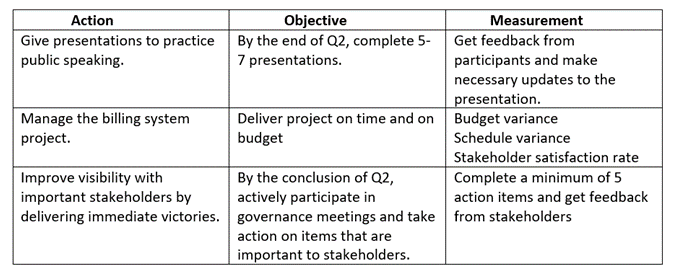
Career Change
A professional in their mid-career can create their own career plan to uncover potential job transitions or advancements. This could be a return to basics in terms of what they consider to be most important to them. Once your objectives have been established, you should do a swot analysis to evaluate your strengths, weaknesses, opportunities, and threats. This leads to actionable objectives for both a long-term and short-term plan.
Sample Career Plan #2
Career Action Plan
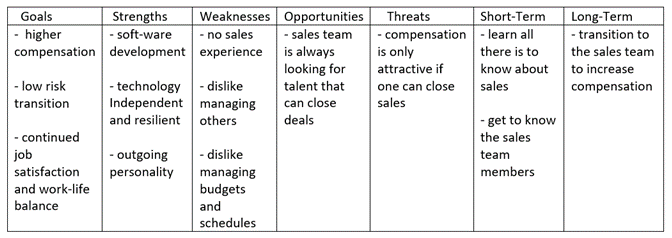
Take massive action. I don’t care if someone has the best plan in the world, if they don’t take massive action to go after what it is that they want, they’re never going to get where they want to be. By taking action, they will start to get results. When they get results, their confidence increases. It’s common for women to have old, limiting beliefs or fears show up.
Even if afraid—do it anyway . . . it will get easier.
Now is the time, to take charge of our future and start creating the career and life that we desire. What we see as possible determines our success. If one sees an opportunity, then they are ready. It is important to always expand our possibilities since possibilities create opportunities.

Exercise 1:5: Create a Career Plan
Have participants develop their own mock career plan. Include what the desired career goal is and include short-term and long-term goals as well as action steps.
Once completed have participants discuss how they can help their team members formulate their own career plan. Share ideas with the group.

Course Manual 4: Your Mindset Shift
In this lesson, we focus on shifting our mindsets. We use the term “mindsets” to refer to common ways of thinking. Throughout the course, we go through a variety of topics and concepts, including narrative. The term “mindsets” has limitations—for example, the concept of mindset shifts can be counterintuitive (if minds are set, this implies they aren’t changeable)—and we’re not claiming it’s the perfect one for every situation. However, there are some benefits to using the phrase. It helps to discern between changes in thinking and changes in discourse, for example, and avoids the combination of the two, which can lead to imprecision in approach and practice.
Change your mindset and transform your life.
The first mindset shift we will address is: How to your Net-worth by increasing your Self-worth.

Let’s look at the difference between self-esteem and self-worth.
The distinction between self-esteem and self-worth appears to be often misunderstood. What exactly is self-worth? Do you automatically think of self-worth as a synonym for self-esteem when you hear the word? Most people, I believe, consider the two terms to be interchangeable. They are not interchangeable. Self-worth isn’t the same as self-esteem.
Let’s look at self-esteem before we define self-worth. The World Book Dictionary, a Thorndike-Barnhardt Dictionary, defines self-esteem as, “thinking well of oneself; self-respect “.
In the year 1657, the concept of having self-esteem was originally proposed. Self-worth was not acknowledged as a distinct notion until 1965, 308 years later. Many dictionaries still use the term “self-esteem” to describe self-worth.
Esteem is when someone or something is held in high esteem or has a good impression of them. It is based on something that has happened in the past, something external. You must be in the present moment to sense self-esteem.
For instance, we can be praised for our ability to do something well or for our performance. This stems from a perception of what others think of us.
So, what is the definition of self-worth? The World Book Dictionary defines self-worth as a favorable estimate or opinion of oneself; self-esteem.” The World Dictionary recognizes the distinction in concept but not meaning. You can view self-worth as a measure of the ability of our Spirit or True Self believes in ourselves – what we are capable of. Self-worth comes from a source INSIDE of us.
We build it by faith, by acting solely on the assumption that we are important. Our ability to believe in ourselves and cherish what we have is built on our sense of self-worth.
Self-worth serves as a conduit for receiving self-esteem.
Self-worth and self-esteem are essential beliefs for self-empowerment. To achieve serenity, love, joy, and power, you must have a valid sense of self-worth. Doubts and worries will endure without self-worth until they invalidate our aspirations and visions, undermining our best achievements.
Now that we’ve defined self-worth, we can talk about how it affects your net worth.
What is a person’s net worth?
According to Investopedia.com, net worth is the difference between the value of one’s assets and the value of one’s liabilities. Net-worth is a notion that applies to both persons and organizations as a crucial metric for determining the value of an entity.
As Jim Rohn brilliantly stated, “Your net-worth will likely never outperform your self-worth.”

5 Easy Steps to Increasing Your Self-Worth and Net-Worth
1.) Consider the following:
What kind of relationship do you have with yourself? What kind of self-care do you practice? How are you treated by others? Your interaction with others improves when you have a healthy relationship with yourself. When they tell you to put your oxygen mask on first before putting it on anyone else, this is an excellent example of this. My personal experiences, as well as those with my clients, have taught me that we cannot be connected and emotionally available to others until we are connected and emotionally available to ourselves.
So, what does a healthy self-relationship look like?
A healthy self-relationship is the ability to value oneself as a person and except and embrace our weaknesses.
A great place to start cultivating a healthy relationship with ourselves is by caring for our physical needs. Including getting plenty of rest, eating a well-balance nutrient rich diet and exercising daily.
Secondly, focusing on your inner world by regularly checking in with our emotions. Get connected with your spiritual self. Focus on joy by prioritizing activities that make you happy. What feeds our mind, body, and spirit?
Finally, act with integrity and be true to our ideals and what matters most to us. Most of the time, how we treat ourselves will determine how others treat us.
2.) Make the decision to go big. We’re not serving the world with our gifts if we are playing small. We shrink to fit in, either so we don’t stick out or because we’re terrified of failing if we put ourselves out there.
Another factor is that we do not believe we are deserving of achievement. In this scenario, we’re often punishing ourselves because of baggage. Whatever it is, accept it, let it go, and forgive yourself. We won’t be able to change anything until we’re prepared to be honest with ourselves. It’s time for each of us to declare our independence and pursue our goals. We’ve earned it!
3.) Make sure we have a clear idea of what we want. It’s critical to get clear on exactly what we want our life and career to look like if we want to build a fulfilling and prosperous future. It’s important to visualize our perfect day, including what we’d like to do, who we’d like to work with, and how we’d best serve our team. We have complete control over creating the career of our dreams, on our own terms…all it’s up to us!
4.) Make a decision on who we will be in order to achieve our goals. We must become the best version of ourselves in order to realize our actual potential. Assess if there are there any areas where we need to improve or develop in order to achieve our objectives?
Tony Robbins’ has a famous quote, “If you’re not growing, you’re dying.” This may appear harsh, yet it makes perfect sense when compared to a plant, notably a fruit. Let’s take an apple as an example. It’s still growing when an apple is still on the tree. However, once it is picked, it begins to perish. This isn’t always obvious; for example, when we see an apple in the grocery store, we don’t immediately think of it as a dying fruit. In fact, we probably think the opposite, that the apple is ripe and it’s at its’ ideal state. This, however, is not the case. Each of us are the same as that apple in terms of personality. On the surface, things may appear to be perfect: expensive cars, a large home, a high salary, and so on. However, we are often dying on the inside. When we appear ripe, we rot. A life in which we are unhappy, discontent, and unfulfilled -is a life without purpose. What adjustments will need to make in order to reclaim our life, serve others, and live a life of passion?
Must expect the best from ourselves. Make an effort, to be the person we want to be, and our brain will follow.
5.) Do the impossible right now. We must push ourselves beyond what we believed was possible in order to reach high levels of success in our life and/or career. This necessitates regularly becoming uncomfortable and moving outside our comfort zone. This is something many success-minded individuals do – to continuously practice; whenever an idea or an opportunity is presented and it makes their heart race, they know it’s something they need to accomplish! It’s during those moments when they ventured outside of their comfort zone that they saw the most growth and improvement in themselves. This is how we, too, can experience exponential growth.
So, in conclusion, we’ve learnt how our sense of self-worth influences our level of success in our personal and professional lives.

To be clear, we’re not talking about self-worth and net-worth being completely determined by the amount of money you have (money does not make us who we are). We’re talking about how our perception of ourselves influences the amount of money or success we can accomplish. Everything we do is influenced by our self-esteem and self-worth.
Success is all about seizing the opportunities that exist around us
We must ask ourselves this very question; “What is the opportunity that I have in front of me now.?”

Here are 7 Mindsets to Adopt, so you can transform your life
1. Decide to take action – Remember if we have an idea, we’re ready. Make a plan and start taking consistent action towards that goal.
2. Everything we experience is an opportunity to learn or have a breakthrough.
3. We must invest in ourselves if we want others to invest in us. This builds our confidence. What we learn will become ours for life.
4. Creating systems and processes will liberate you. When we are prepared, we will allow our creativity to work for us.
5. Fear and doubt are not real and are never the truth. We must have faith in our goals and focus on what really matters, which is how we can help others with our gift. It is not about us it’s about them.
6. Invest in a Mentor. If we want to remove the guesswork and a lot of the struggles, we can hire someone who can show us how to get from where we are to where we want to be. This will save us a lot of time and money in the end!
7. Be present to the opportunities in front of us. We can use our intuition to guide us in the right direction. All we have to do is ask ourselves the following 2 questions; “Will this take me closer to my goals or away from my goals and “Is this decision in alignment with my values?”
Shifting Employee Mindsets for a Successful Change Initiative
A good strategy will always be ruined by poor execution. Executive and leadership teams devote numerous hours to developing strategic objectives, but they frequently underestimate the time required to carry them out successfully. According to McKinsey study, only about 30% of strategic transitions succeed. Poor communication, a lack of a compelling change story, and people who don’t feel seen and heard are at the root of the breakdown. In short, they aren’t “bought in.”
Being “bought in” does not happen just because a project is introduced. In truth, buy-in is a mindset that develops over time as a result of tiny, persistent steps. The authors of a recent Harvard Business Review article highlighting the successful strategic digital transformation of an Austrian waste management company credited the achievement to various factors, one of which was having the “correct talent and mentality” among companies. They cited “a transformational leadership style — focused on empowering and inspiring workers to become self-starters and take ownership of their role” as a key component in adapting to change.
Career paths, resource libraries, and asynchronous training aren’t enough to provide employees with the tools they need to create personal accountability and ownership of their jobs. Before those tools can be useful, there needs to be a mentality shift.

The Push-Pull Challenge
Typically, companies provide employees with a massive number of resources with the idea that they will extract the information that is most relevant to their careers from that content. The problem with this strategy is that employee engagement remains low, discretionary effort is non-existent, and people continue to expect employers to tell them how to advance in their careers.
This method will not produce self-starters. Instead, businesses require a mental shift in which employees are encouraged to “pull in” what they require and “push up” creative ideas, worries that may stymie the change effort, and novel problem-solving methodologies.
It is the role of a leader to develop self-generated insight rather than to offer all of the solutions.
Developing a Personal Ownership Mindset
It is the role of a leader to develop self-generated insight rather than to offer all of the solutions. This method necessitates deliberate effort and forethought. Here are five strategies to help employees change their ideas, gain confidence, and take ownership of their current role and future roles.
Strategies to Shifting Employee Mindsets for a Successful Change Initiative
1. This is your journey to take. -There is no roadmap for progressing to the next level. Others have opened doors for each of us. The path to owning one’s role, as well as the challenges that arise along the way, are both challenging. It’s impossible to put yourself in someone else’s shoes.
2. Make it clear to employees that a job description is only a guideline. – Employees should be told that just because they don’t check every box on a job description doesn’t mean they aren’t qualified. This education is especially crucial for women, who, according to research, are more prone than males to not apply for a job if they don’t meet all of the requirements. Create an environment that encourages people to be vulnerable and step outside of their comfort zones. If they haven’t had the chance to interview and receive feedback along the route, they won’t be ready for their dream job.
3. You Achieve What You Measure – Set expectations. Better yet, require employees to track the impact they make in their role on a weekly basis. Have them record their wins, losses and lessons learned from each. When you foster accountability in this fashion, employees will be more likely to take ownership of their role while building their confidence along the way.
4. Redefine Failure – Consider failure as a springboard for success. The leaders we become later in our careers are shaped by the mistakes we make and the lessons we gain from them. Setting limits on decision-making and problem-solving is a smart place to start when it comes to developing a culture of safe failure.
5. Make Detailed Positive Feedback Work for You -Managers should be trained to provide specific positive feedback (also known as praise) so that employees know what they should do more of and are confident in the skills they are learning. Employees that are given positive feedback in a skillful manner become self-starters and take ownership of their responsibilities since they know what they need to do to accomplish goals.
Employees will understand they’ve been given the tools they need to manage the change ahead if they focus on developing their talents and adjusting their perspective. It’s up to them to do the rest.
Employees will be more likely to take responsibility of their roles and gain confidence if you create accountability.

Exercise 1:6: Create a Vision Statement
Write down your thoughts and ideas of what your career will look like a year from now. Be as specific as you can! (Make sure you also do this for your 1 year, 3 year and 5-year vision)


Course Manual 5: Building Confidence
People that are self-confident appear to be at ease with themselves and their work. They invite others to trust them and instill confidence in them. These are all desirable qualities to possess. But being confident in yourself isn’t always simple, especially if you’re naturally self-critical or if others put you down. There are, thankfully, steps one can take to boost and maintain their self-confidence which we will cover in this lesson.
What is confidence?
According to the dictionary confidence is a feeling of self-assurance arising from one’s appreciation of one’s own abilities or qualities.
Confidence in the workplace
Confidence is a quality that not everyone possesses. Although not everyone has the ability to go into a room and ooze charisma and flair, confidence is a quality that may be quite beneficial in the workplace. It can assist us in interacting with our coworkers, keeping us motivated through tough moments, and increasing our productivity during the workday.
Being assertive can give employees an edge. Being assertive does need not imply aggressiveness or arrogance. Assertiveness refers to one’s ability to take charge of projects and deal with pressure without becoming stressed. It also implies that we’re willing to take on more responsibilities at work.
Being confident will help you advance in your work. Management will notice when we can manage stressful situations with ease and that we can come up with creative solutions to problems on our own. Confidence will help us improve our performance at work, which could lead to a promotion.
Confidence in Communication
A major advantage in every office is the ability to communicate clearly and effectively. Confidence permits you to accomplish this quickly and efficiently, allowing you to communicate effectively with coworkers and clients.
It may seem difficult at first to project a confident demeanor when conversing, but with practice, it will become second nature. When it comes to hiring new talent, communication skills are near the top of practically any employer’s list and being self-assured will help you develop them. A self-assured individual is confident in their ability to communicate, which is reflected in their spoken and written language.
A Boost in Productivity
We are more likely to be productive if we are confidence in ourselves and our work. Because we won’t have to second-guess our work, we’ll be able to finish assignments on time and on budget.
In any firm, productive employees are highly prized, and confidence goes hand in hand with creating results. One will be able to take on additional projects, push themselves to break out of their comfort zone, and achieve new corporate goals. Because they generate high-quality work, their employer may see them as a candidate for new challenges, a career change, or even a promotion.
Confident people are more not concerned on the impact others will have on them but more concerned with the impact they have on others. To build confidence, it is necessary to change our mindset and consider what we can do to impact our coworkers.
This adjustment in perspective will empower us because we will realize that it is what we do, not what others do to us, that matters. We should also consider how we deal with stress. If we’re someone who normally seeks assistance in stressful situations, it is important to attempt to shift our mindset to seeing ourselves as someone who can offer counsel. A simple change of perspective can make us feel more self-assured, and others will soon follow our lead.
Sharing goals with others
Feeling confident starts with stating our goals and believing that we can accomplish them. Declaring our goals aloud will offer credibility, and others will notice that we keep our promises. We must be certain that anything we take on can be completed by the deadline; else, incomplete jobs and a heavy workload will undermine our self-assurance. By making good use of our time, we’ll be able to complete any work we set our mind to.
Knowledge is Power
One can simply boost their confidence by expanding our knowledge and studying new things. This can be accomplished quickly by viewing TED Talks on topics that interest us, attending self-confidence workshops, or enrolling in online courses in our industry.
When we study more about a topic we enjoy or improve our skills in our career, our confidence grows. We’ll also get new skills that will help us improve our job performance and raise our confidence. It’s never too late to learn something new, and we shouldn’t let our age stop us from enrolling in classes or attending seminars.
People who are self-assured are confident and self-motivated, have a strong sense of self-worth, and are willing to take calculated risks. Confidence is also the most important personality quality for a person’s capacity to deal well with organizational change.

5 Tips to Build Confidence
1). Play to our strengths – Let’s look at a story of a women who was extraordinary at her job. Her boss thought she was the smartest and most imaginative person he’d ever worked with. The issue was her husband had to re-locate for his job and she had to move along with him. He wanted to pay for some private coaching for so when she applies for a new job, she comes across as the amazing person she is.
She met with the coach who was excited to meet this accomplished woman. “This is a tremendous joy,” she replied as she entered her office. I’ve heard a lot of good things about you. Tell me about your background. What is it about you that you excel at? What do you want a potential employer to know about you the most?”
The woman was silent for several seconds. Finally, she sighed and said, “I really don’t know. I do a lot of things well, but when I do them, I don’t notice.”
Surprisingly, competence has little to do with self-assurance. The fact that someone excel at their job does not imply that they are confident in their talents. Only when you are aware of your abilities can you feel confident.
An excellent tip for enhancing our awareness of our skills and talents is particularly useful right before a job interview or any other crucial event where we want to project our most confident self. Consider a former feat that made you proud and gave you a sense of accomplishment. (This doesn’t have to be from your work life however, it’s recommended that we create a “success record” so we can quickly recall our accomplishments.) Then think about how powerful and certain you felt. Remember or picture how you appeared and sounded when you were younger. As you enter a meeting room or walk up to the stage, recalling that true emotion will help you live it.

Exercise 1:7 – Share one of your successes
Have each participant share the story of one of their successes and how they felt afterwards.
2). Be aware of our posture.
It is important to note that how we feel has an impact on our body. We tend to round our shoulders, droop, and look down when we’re feeling uneasy or unhappy. When we’re happy and confident, we tend to stand tall and broaden our chest. Did you realize, however, that the opposite is also true? Our posture has a significant influence on our emotions and how others see us.
According to Harvard and Columbia Business Schools research, simply holding our bodies in expansive, “high-power” stances for two minutes increases testosterone levels – the hormone associated with power and dominance? It also lowers levels of cortisol which is a stress hormone.
The researchers discovered that these powerful postures lead to heightened sensations of power and a higher tolerance for risk, in addition to generating hormonal modifications in both males and females. They also discovered that how people feel about you has a greater influence on them than what you say.
Start by standing up straight, pulling your shoulders back, widening your stance, and holding your head high before going into a setting where you want to project your most confident self. Then, in a “Wonder Woman” pose, put your hands on your hips. Simply by maintaining this stance, you will begin to feel more confident in yourself and exude self-assurance.
3). Choose optimism.
The Chinese word for crisis comprises two characters: one represents danger, and the other represents opportunity. Is the glass half-full or half-empty? It’s both. The only distinction is in where you direct your attention.
A positive attitude has long been recognized as an important component of high-level success and confidence. A cheerful, enthusiastic, “can-do” attitude is critical for success in today’s fast-paced, competitive corporate world.
4). Relax
In order to plan for the future, we must define goals and make plans while considering a variety of scenarios in a changing environment. Then we must accept that, despite our best efforts, the future may not turn out as we had hoped, and we will almost certainly be forced to reorient as circumstances change, often in unexpected ways.”
Some people are naturally more adaptable and flexible than others when it comes to dealing with and adapting to a complicated, constantly changing reality. (These people are often referred to as “change adepts.”) They’ve discovered that in chaotic times, the key is to relax and learn to roll with it, rather than brace for it.
You should not be blind to potential danger just because you choose not to dwell on negativity. Instead, you can assess circumstances for both positive and bad elements, devise tactics to mitigate negatives while maximizing positives, and then concentrate on the situation’s favorable features.
By honing our capacity to commit to a course of action while being flexible enough to change behaviors and attitudes rapidly to support a goal, we can build resilience and confidence.
5). Embrace Failure
It is crucial to remember that failure is an opportunity for growth.
“You gain strength, courage and confidence by every experience in which you really stop to look fear in the face. You are able to say to yourself, ‘I have lived through this horror. I can take the next thing that comes along.’ You must do the thing you think you cannot do.” ― Eleanor Roosevelt
Whoopie Goldberg revealed how she landed her first one-woman show in New York in a television interview. Mike Nichols (the filmmaker) was in the crowd while she performed her nightclub act. He approached her backstage and offered to write a Broadway show for her. Whoopie opined that she wasn’t sure that was such a good idea. What if she was a lousy? Mike inquired if she’d ever been a lousy before, to which Whoopie replied, “Sure!”
His response was, “Then it’s no big deal. You’ll just be lousy on Broadway.”
What an excellent response.
The United States Army created the After-Action Review to foster this type of productive thinking. Organizations across the world are already using AARs to help teams learn from their failures, prevent future mistakes, and identify new solutions to challenges.
In essence, the AAR process brings together those who were involved in a planned project and asks them to respond to a series of questions:
1. What was the desired outcome?
2. What was the actual outcome?
3. Why were there differences between what I wanted and what I achieved?
4. What did I learn?
5. What would I do differently next time?
We can conduct our own private AAR following any significant event that did not go as planned.
Fear of failure is a significant impediment to self-confidence development and projection. However, knowing that our failures will not deter us will boost our confidence and allow us to realize that nothing will be able to stop us!
Growth comes just as much from failure as it does success. One project manager shared this when she was asked about failure, “If this venture fails, it will still be worth all the time and effort I’ve put into it for the past 18 months. Just look at everything I’ve learned.”
The only difference between those who drive towards their goals and get what they want in life and those you can’t is CONFIDENCE. Once we truly realize just how capable, talented, and amazing we are; that belief along with a calm faith-based sense of certainty is the key ingredient in truly realizing our value and have others realize it to.

Exercise 1:8: Practice Your Wonder Woman Pose
First, have each participant start by standing up straight, pulling their shoulders back, widening their stance, and holding their head high. Then have them think of a situation where they would want to show up as their most confident self. Then, in a “Wonder Woman” pose, have them put their hands on their hips. Maintain this stance.
Then, ask the participants how they feel while in their “power pose”?

Course Manual 6: Visualize Dreams
Visualize Dreams – Visualization is a powerful tool to assist us in reaching our goals. The Law of Attraction and the power of vision go hand in hand. The concept is to envision an image in our mind that will be drawn to us if we visualize it often enough. We probably already do this without even realizing it! In this lesson, we will reveal a proven method how.
Visualization is a concept that is increasingly being used in the media and in the spotlight. There are many misconceptions regarding what this word signifies and the impact it can have. The act of vision is credited by many successful people as the key to their success. Many people are attracted by this, yet many still have a misunderstanding of what visualizing entails. This causes individuals to wonder what it is, how to accomplish it, and what kind of impact it will have on their lives.
It was Wallace Wattles who first introduced the use of creative visualization. Wattles is best known for his book The Science of Getting Rich, published in 1910. His work clearly had a major influence on later self-help authors such as Napoleon Hill. And his book The Science of Getting Rich was itself a direct inspiration for the very popular book and movie, The Secret.
What is visualization?
If unsure about the definition of visualization, looking it up in the dictionary can lead to even more confusion. “the formation of mental visual images or the act or process of interpreting visual terms or of putting them into visible form,” according to the Merriam-Webster Dictionary. For most people, this definition probably doesn’t help us understand much of anything.
The following is a simplified form of the visualization definition: visualize the things you want in your life in your head. Visualization is frequently used in conjunction with meditation and mindfulness. Going to a peaceful spot, closing your eyes, and calming your body, and beginning to think about things you want to experience in life would be one example of this approach. We want to be as specific as possible during this process.
1st Example
For example, if you wish to receive an award for your work in the future, close your eyes and visualize yourself receiving the prize. You might imagine how it would feel if your name were called as the winner. You would consider what you were wearing and how you appeared. You may even picture who is presenting you with the prize, what they are saying about you, and how it feels to hold the award in your hand.
2nd Example
Consider sports to get a better idea of what visualization looks like. Many elite athletes employ visualization to prepare for games. Shooting the ball, passing the ball, tossing the ball, catching the ball, hitting the ball, kicking the ball, or whatever their sport requires are all on their minds. Basketball players were able to enhance their percentage of made free throws by simply picturing making free throws without ever practicing shooting the ball, according to studies.

The science behind visualization
If you’re new to the concept of visualization, you might be wondering if and how it can genuinely work. Visualization is nothing more than mental conditioning. In a way, you’re rehearsing for whatever it is you want to experience in your life. The more you concentrate on something, the more likely it is that it will appear in your life. You’ve probably heard that you receive what you anticipate in life. If you don’t expect much from life, you’re more likely to get what you want because your mind has settled, and you’re not compelled to go after what you actually want.
When you spend time actively picturing what you want for yourself, on the other hand, you are developing the motivation to go after it. The more you imagine it, the more you’ll be able to see and believe that it can happen in your life. You’ll be on the lookout for possibilities to make it happen.
The science of visualization is based on your brain’s neuronal processes. As you continue to think about and imagine the things you want in your life, brain patterns form in the same way that they would if you had actually done the action. This is how basketball players were able to improve their shot % without ever shooting a basketball in practice. They were preparing their minds to be successful shooters. Even if you have never participated in the activity before, your neurological system gets activated simply by thinking about it.
“Everything you can imagine is real.” – Pablo Picasso
How to visualize
If you want to begin incorporating visualization into your daily routine, these are the steps to take.
1. Sit in a peaceful location. Make sure you’re in a quiet area where you won’t be interrupted.
2. To help yourself relax, close your eyes, and take several deep breaths.
3. Begin to consider the result, object, or circumstance you desire in your life. Imagine it as specifically as possible, including every detail that comes to mind. Make careful to include your feelings and emotions about what you’re envisioning in your visualization.
4. Practice this at least once a day, ideally twice a day.
How Can Visualization Help Transform Our Lives?
Now that you’ve mastered the definition of visualization, it’s time to discover how it might benefit you in your daily life. Here are some ways that incorporating visualization into your daily routine might benefit you.
Improved Performance
As previously said, many athletes use visualization to improve their athletic abilities. This, however, can also apply to non-athletes. Visualizing your work performance might assist you in producing better results and increasing productivity.
One factor for your improved performance is because you are more focused on your work. Through visualization, you’re teaching your mind to concentrate. Other people and technology, among other things, work to divert us throughout the day. Our brains become accustomed to continual stimulus and activity, but it also makes it more difficult for us to concentrate. When you practice visualization, you establish a routine for calming your mind, which aids in the training of your ability to focus on one item at a time. Your brain is being retrained to focus.
Overcome Anxiety
A huge percentage of people despise public speaking or have true phobias about it. Standing in front of a huge group of people or presenting a presentation in front of a conference table full of coworkers are examples of this. If you have a presentation coming up, visualizing might help you overcome your worry and anxiousness. Visualizing yourself presenting your speech and receiving a positive reception will help you recall it. It also allows you to walk into a performance with more confidence when you are well prepared.
Discover what you really want
Life is hectic, and if we don’t take the time to consider what we really want, we will never know. You become more in tune with yourself when you spend time picturing scenarios and going through the details of them. You begin to gain a greater understanding of yourself. You can visualize the things you desire to accomplish in life. This helps you understand why you want those things on a deeper level. Working via visualizations can help you set clear goals and have a better understanding of what you want. The more specific you are about it, the clearer you will become about what that means in your life.
Reducing Stress
You’re taking time out of your day to visualize, which helps you move away from the stress in your life. You’re soothing yourself from the inside out, which might help relieve stress-related hypertension. You’re learning to keep your ideas under check. If you’re constantly in stressful situations, this is a valuable skill to have. You may take control of what you’re thinking about and how your body reacts by using visualization.
Even if you don’t have time to move away and find a peaceful area, you may learn to manage your body’s reaction and calm your mind by continuing to practice visualization. These techniques can also be used to help you fall asleep.
There are many various ways to talk about visualization, and many successful people use it to achieve their goals.
Do you want to be a famous speaker? Do you want to be a leader in your company? Feel great about your body? Then see yourself achieving it! “See it to be it” is what athletes say to visualize success. Live on your terms, no one else’s. Create a new empowered version of yourself.

The Law of Attraction
The Law Attraction focuses on the idea that what you think about you bring about or like attracts like.
We are responsible for bringing both positive and negative thoughts into our life, whether we know it or not. Understanding that where you put your focus has a big impact on what occurs to you is a big aspect of the Law of Attraction. You’ll notice more negativity if you spend your days wallowing in regrets about the past or anxieties about the future, but if you look for the silver lining in every event, you’ll soon start to see optimism all around you. As a result, the Law of Attraction encourages you to recognize that you have the power to direct how your future unfolds, shaping it in the ways that you choose.
Whatever you want, whatever your hopes and goals are, the Law of Attraction may teach you essential lessons that will help you achieve your most cherished desires.
Although studying what the Law of Attraction is has a lot of value, you can really start applying it to its full potential once you realize that it can be applied in subtle ways every minute of the day. Developing a greater awareness of your own thoughts will assist you in determining what you should preserve and what you should discard from your own mind and the reality of your experience. You’ll become more aware of underlying negativity, and you’ll be able to start combating it with new thoughts and sentiments that better reflect your optimistic outlook for the days ahead. This continuous focus on self-reflection also allows you to recognize what you actually want from your future, and you can then move on to setting more specific objectives with practical tasks at each stage.
There are dozens of ways to apply what you’ve learned about the Law of Attraction in your daily life, allowing your new abilities to impact your day from morning to night. While this may appear to be a daunting task, the truth is that when working with the Law of Attraction, small modifications can have a big impact. Much of your new strategy will become second nature after a few weeks of practice.
Creative visualization is an essential element of using the Law of Attraction, and meditative exercises are part of this process.
Internal thoughts or spoken words can be used as affirmations, but they can also be expressed visually. You may design them to represent your vision of how you want your life to improve, regardless of how you utilize them. Many people, for example, have found that speaking affirming words into the mirror before heading to work or saying “today is going to be a terrific day” in the morning can help them feel more positive. Affirmations can help you employ the Law of Attraction more effectively by helping to modify basic beliefs and assumptions that may be holding you back. They encourage persistence, optimism, and a laser-like concentration on the future you desire.
Affirmations
Visual affirmations can also serve as a helpful reminder to keep connected to positive thoughts throughout the day. If your confidence is waning, a sticky note on the bathroom mirror, the fridge, or the front door can serve as a reminder, and a “dream board” can be created to visually express your desires and goals. We’ll go over how to utilize affirmations in a variety of ways and how to build them to appropriately reflect your underlying goals.
Law of Attraction Exercises
While affirmations and visualizations are two of the most powerful tools you have when working with the Law of Attraction, they are far from the only ways to manifest the life you want. There are Law of Attraction exercises that target negative feelings and help you focus on discarding them, as well as strategies to prevent self-defeating beliefs from arising and taking hold. Meanwhile, there are social strategies that improve your communication and help you transmit positivity wherever you go, as well as ways to modify your living area to better represent your aims and encourage an optimistic outlook.
Visualizing Success
Three powerful examples of successful people and how they used visualization to reach success:
Muhammad Ali, the legendary boxer, was always emphasizing the necessity of seeing himself triumphant long before the match.
Jim Carrey used to imagine himself as the best actor in the world when he was a struggling young actor.
Michael Jordan always imagined himself taking the final shot before attempting it in real life.
You don’t have to spend loads of time visualizing. Simply make it a habit to incorporate a positive vision into your daily life. Visualize yourself succeeding, attaining all of your objectives, and finishing all of your tasks. Take a look at what it does and how it makes you feel. This will almost certainly become a key component of your success strategy.
We must love ourselves as we are and recognize our God-given talents and strengths or unique characteristics. The most important part of reaching any goal is our perception of ourselves.
The truth is that if you can’t visualize yourself being highly successful, dominating your industry, and being an incredible leader in your imagination, you’re unlikely to achieve it.
This should help you get things rolling.

Here are 6 Ways to Help You Visualize Success
1. Read inspiring books and stories – Read about others who have achieved success in the area that you’re interested in. This will allow you to believe that it’s possible.
2. Create a vision board – Put together pictures and affirmations of what you want for yourself and your family and what you want your lifestyle to look like.
3. Meditate daily – This is a great way to set your intentions for the day. Sit in a quiet place, take some deep breaths, and focus on getting into a peaceful state. (I focus on the things that I’m grateful for such as my family, my friends, my health, and the opportunity to serve others with my gift) this helps to remove what I like to call the “monkey chatter” going on in my mind. Then, visualize what you want for yourself or how you want your day to go. Be very specific! This is so powerful. The universe will open-up and create opportunities that will help you reach your goals.
4. Journal daily- Write down your thoughts, words, or phrases to describe what you want to achieve in your life or business or if you’re more visual like me you can use mind mapping with pictures to convey your thoughts. Be sure to write down the value you offer and what unique gifts and skills you possess that will allow you to succeed.
5. Hang around other successful and positive people- start making time to connect with other like-minded individuals especially in the area you’re looking to succeed in. You can learn a ton! Even hire a coach or mentor as I mentioned earlier in the chapter, they can show you the way and eliminate any guess work avoiding timely and costly mistakes. They will be your biggest cheerleader!
The key is to just start taking action- Start moving in the direction of our goals. Just by taking that action it will motivate us to continue to move forward. Once we set small goals for ourselves and achieve them, we will gain more and more confidence along the way.

Exercise: 1:9: Practice Visualization
Have participants follow the Visualization process presented in this lesson
1. Sit in a peaceful location. Make sure you’re in a quiet area where you won’t be interrupted.
2. To help yourself relax, close your eyes, and take several deep breaths.
3. Begin to consider the result, object, or circumstance you desire in your life. Imagine it as specifically as possible, including every detail that comes to mind. Make careful to include your feelings and emotions about what you’re envisioning in your visualization.
Share experience with your fellow participants.
Exercise 1:10: Adopting Visualization Into Your Life
Have each participant pick 3 of the above Visualization Tips that they will commit to implementing over the 7 days.
Share with the group.

Course Manual 7: Investing in Yourself
Investing in ourselves is the best return on investment we can have. Whether it’s developing our career, learning a new skill, working on your creativity or personal development; we need to give to ourselves first before we can give to others.
Why is investing in yourself so powerful?
Investing in ourselves sends a powerful message to ourselves and the world. The message is: The value and potential that I possess, is important enough to me that I’m going to give it the energy, space, and time to grow and create results. In this lesson, you will powerful strategies and discover the top 10 ways to invest in ourselves.
So, it’s not always money that’s required, when investing in oneself, time and energy are just as important. Investing in yourself, requires learning how to maximize the unlimited potential that lies within your mind and body.
“There is no more profitable investment than investing in yourself. It is the best investment you can make; you can never go wrong with it. It is the true way to improve yourself to be the best version of you and lets you be able to best serve those around you.” ― Roy T. Bennett, The Light in the Heart
Another compelling incentive to devote time and money to your own development is because no one else will. You and only you have control over your life and career. It will not happen unless you work on learning new skills, improving your life, and developing your imagination.
Physical health, emotional health, employment, education, goals, artistic endeavors, passions or interests, and relationships are all areas where we can invest in ourselves.

Case Study:
One day I met with a potential client for my coaching business named Lisa at a local Starbucks. Lisa was referred to me by a friend. Lisa is a very talented, yet struggling, Interior Designer. She was also feeling somewhat depressed and not very inspired. She said that one of her goals was to be able to get to a point where she could wake up in the morning and actually feel excited about the day. Lisa’s world revolved around taking care of her husband and kids and she didn’t do much for herself. She had been doing quite a bit of interior design work for some friends and family. They absolutely loved her work and continually praised her and told her how talented she was. The problem was that nobody ever offered to pay her, and she was afraid to ask them to pay her. This led to Lisa becoming quite frustrated and even resentful. I told Lisa that I could help her, and one of my specialties was helping individuals own their value so they can get paid what they’re worth.
I offered Lisa one of my coaching programs that would assist her in building a successful business that she could be passionate about. I remember, there was a lot of fear coming up for Lisa she had never done anything like this for herself. She had never “invested in herself” like this before. But, regardless of the fear she decided to move forward. I remember her writing me a check right then and there for the coaching program.
I remember getting a call from Lisa, the very next day, she said, “You’re never going to believe what happened a few hours after I met with you yesterday; I got a call from my friend (ironically, it was actually one of the friends that were taking advantage of her services) and she told me about an event she was asked to coordinate. She needed someone to be in charge of the decorations and she offered the job to me. The best thing was it is a paying job and the amount she offered to pay me, just happened to be the exact same amount that I had just invested in your program!” How cool is that!
When we’re willing to say yes to ourselves and take that leap of faith the universe will provide us with amazing rewards. It’s like telling the universe- I’m worth it!
Investing in ourselves and what we have to give the world can be one of the most profitable decisions we ever make.
Not only does it improve our career options, but it also increases your overall life satisfaction.
Take this scenario, for example:
Back in high school, Mary and Eileen were good friends. After graduation, Mary went to study abroad with her family, while Eileen stayed in the city to get a degree.
After some years, Mary went back to the city because she got a job offer. While on her way to the company for an interview, she saw Eileen having breakfast at a local cafe.
She went inside because she had a few minutes to spare. When Eileen saw her, she was taken aback and greeted her with delight.
When Eileen inquired as to why Mary was here, Mary stated that she had an interview for an operations manager position with a sales company, which was a level higher than Eileen’s current one.
“Our grades were virtually the same in high school,” Eileen marveled to herself. We both passed our college exams with flying colors. We share a similar work ethic. “What happened?” you might wonder. “You have a degree in computer programming, right?” she inquired of Mary. Cool, now you’re in sales!”
Mary said, “Oh, yeah.” “However, I took online marketing and advertising classes. I was fortunate to acquire a job as a sales manager in a small company while I was studying. I also made my own website and displayed my portfolio there because I’m a computer programmer. The webpage was seen by the director I’ll be meeting with today. That’s an opportunity I can’t refuse.”
In this instance, the contrast between Eileen and Mary is evident. What was the difference?
Mary made an investment in herself. She picked up a new skill, acquired a part-time job, and began blogging.
What can be learned from this example? Investing in yourself is time and risk well spent. You’ll never know unless you give it a shot. And until you try, you will never achieve your full potential in life.
Let’s look at some incredible ways that we can invest in ourselves.

Top ways to invest in Yourself
Establish goals
Learn how to set personal and professional goals. It’s like driving in the dark with your headlights turned off if you don’t take the time to set goals. You’ll have no idea where you’re heading and will waste valuable time. Make sure to include some deadlines for meeting them.
Trust your intuition
You can show yourself love by trusting your instincts and listening to what they’re telling you. You will be able to make better selections if you pay attention to your intuition. It’s tremendously empowering to value your intuition by refusing to let other people’s opinions, feelings, or words detract from what you know to be true. By paying attention to how you’re feeling, you’ll be able to make better, more informed, and faster judgments. When I choose to reject my gut or intuition when I have a strong feeling about something, I almost always end up regretting my decision or behavior. I’ve learnt to always trust my intuition, and it’s what guides me in my personal and professional life.
Invest in your creativity
Our creativity doesn’t have to diminish as we get older. In fact, it is believed that the peak of creativity in most people is around 3-40 years old. (Lindaur, 1198, Marisiske &Willis, 1998) Creativity can be the catalyst in the manifestation of continual learning and lifelong activity. It allows us to be inspired, have fun, and appreciate the beauty in the world.
Scientists and artists alike have studied creativity, and some of the experts have identified some extremely beneficial strategies to assist you in becoming more creative. These techniques are beneficial to any entrepreneur, but they are especially beneficial to those who code, write, design, or create for a living.
Now, let’s take a look at seven of the most effective strategies to invest in your creativity, divided into three categories: mentality, approaches, and internet tools.
Let’s get started!
Embrace Your Own Creativity
Many people believe that you are either born creative or you aren’t, but this isn’t the case. Even the most routine tasks, such as cooking, can be incredibly creative. Rather than telling yourself you’re not creative, strive to accept and appreciate the truth that you are, and purposefully cultivate your creative habits.
This is supported by research released by the American Psychological Association, which advises the following strategies:
• Write down your thoughts – even if you have to scribble on a napkin. This encourages the subconscious to keep coming up with new ones.
• Set a goal for yourself: To get out of mental ruts, take on unreasonable, fictitious difficulties. Consider how you might be able to make skyscrapers fly or luggage load themselves.
• Consider it for a while: In dreams, or in the hypnogogic condition between sleep and waking, we frequently come up with new answers and ideas.
• Get happy. Positive emotions support a more loose-knit approach to problem-solving and innovation, whereas depression inhibits creativity.
Change Your Thought Patterns.
According to Susan K Perry of Psychology Today, ““We tend to think about things in habitual ways, overlooking the secondary, more imaginative ways to use them,” Put deliberate limits and hurdles in the path of your creative work to shake things up. Limiting your time or space to come up with something, for example, will often result in fresh, new thoughts.
Go for a Walk
Walking can help you be more creative, according to Stanford University research. Sometimes all it takes is a quick walk to have an aha! moment. It’s sounds simple, yet it works.
Use Meditation to Clear Your Mind
A study published in Science Daily found that just 25 minutes of meditation can greatly improve creative thinking in 40 people, many of whom had never meditated before.
Put yourself in a creative frame of mind
To get into a creative mindset, try one of these basic techniques:
• Turn off all electronics and isolate yourself from all sources of distraction — silence is golden.
• Try something new – a factory, a landfill, or the countryside can all serve as catalysts.
• Daydream.
• Play and have a good time.
• Create psychological or physical distance between yourself and the task — sometimes all that’s required is a new perspective.
• To stimulate creativity, create a mood or a strong emotion.
Put a Creativity Technique to Work
Experts in the field of creativity have devised a variety of formal strategies for solving difficulties and bringing ideas to the surface. Some of them, like the classic brainstorming session, are best done in groups, while they can also be done alone. Here are a couple of the more effective methods:
• SCAMPER
Bob Eberle explored the notion that everything new is merely a modification of something that already exists. It’s a sentiment shared by Steve Jobs, who said:
“Creativity is just connecting things. When you ask creative people how they did something, they feel a little guilty because they didn’t really do it, they just saw something. It seemed obvious to them after a while. That’s because they were able to connect experiences they’ve had and synthesize new things.”
Eberle’s Technique has a few variations, but the basic idea is taking one key concept and modifying it in various ways to stimulate new creative outcomes.
Each letter in the acronym represents a different way you can play with new ideas:
• Substitute: What happens if we switch two things around?
• Combine: What if we add this these two things together?
• Adapt: Is there another use? Can we invent one?
• Modify: What can you emphasize, hide, or change?
• Put to Other Uses: A brick can be a paperweight. A shoe can be a doorstop.
• Eliminate: What can we delete – and what does that do?
• Rearrange (or Reverse): Why not turn it upside down?
De Bono’s Hats
Edward De Bono coined the term “lateral thinking,” authored the book The Six Thinking Hats, and is a proponent of thinking education in schools. He stated, ”
“We really need to stop considering thinking as simply ‘intelligence in action’ and think of it as a skill that can be developed by everyone.”
You put on a figurative hat, think only what the hat allows you to think, and then swap it around in the Six Thinking Hats approach. Forcing yourself to think in a certain way can lead to new and interesting mental connections. The following are the hats:
Blue Hat: The organizer and planner. The big picture.
White Hat: The facts only. What do I know, and what else do I need to know?
Green Hat: The creative. The free flow of associations. All possibilities.
Yellow Hat: The optimist. All the pros – none of the cons.
Black Hat: The pessimist. Just the cons and risks.
Red Hat: The emotions. Feelings, intuitions, and hunches.
Lateral thinking is a word that describes thinking outside the box, finding new perspectives, and taking innovative ways. It’s not the typical linear, logical way of thinking.
Another way stimulates your mind to develop new connections by using random phrases, images, and thoughts (that are unrelated to your problem or desired outcome). This is a great way to get people to think about things in new ways.

Use an Online Tool as a Creativity Prompt
In the blog post, Ways for Creative Entrepreneurs to Spark New Ideas and Invite Inspiration, the author shares a number of online resources that act as prompts to spark your creativity:
1. Need an idea for a blog article? Portent’s Content Idea Generator gives creative entrepreneurs title ideas to tweak and make your own.
2. The Idea Lottery from Idea Champions generates random connections between words using a grid format to spark new trains of thought.
3. Creativity Games has a simple random word generator to stimulate lateral thinking.
4. The imagination prompt generator might be useful for stimulating writing ideas in a pinch.
5. Or, if you’re open to random suggestions to solving a tricky problem, try digging into the magic sandbox from Idea Sandbox.
6. The Creativity Pool contains hundreds of unused ideas for products uploaded by creative entrepreneur from all over the world. Some are terrible, but you might find a gem of inspiration between all the rest.
Invest in building your self-confidence
People who are aware of their worth have something to say, and others will pay attention. You can invest in yourself by gaining a better awareness of the value you have and can provide to others. When you learn to express your truth with confidence. The more you appreciate yourself and own your worth, the more comfortable you will be sharing it with others. (Learn more about building your self-confidence in Couse 1:5)
Read books that are educational
Books and audio books are a fantastic way to expand your knowledge and expertise in any subject.
Attend seminars and workshops to broaden your business and/or personal knowledge and abilities
This will also provide you with the opportunity to meet and communicate with people who share your interests.
Make your health a priority
Every day, feed your body with nutrition by eating well. You will feel better and have more energy if you focus on eating organic and healthier options. I understand that eating an unhealthy burger or cupcake provides us with immediate gratification, but if you’re anything like me, you’ll regret it later because you’ll feel terrible. Exercise on a daily basis. Every day, do something to get moving and raise your heart rate. Even if it’s simply taking the dog for a walk. Exercise provides you with the energy to face the day with self-assurance in how you look and feel.
Make the decision to be happy
Happiness is something that may be chosen. Rather than focusing on the negative parts of life, happy people opt to focus on the positive. Their circumstances do not hold them hostage. They consider every reason to be grateful. “Most people are about as happy as they make up their minds to be.” – President Abraham Lincoln
Make progress on your bucket list
Take some time to start making a bucket list. Your bucket list is a list of all the things you desire to accomplish, see, feel, and do in your life. Your list may grow over time but start with 100 items. Then, every month or so, check to see if you’ve completed one of the items on your list.
Hire a coach to help you
All of these techniques can be put into action with the help of a coach. A coach is your success partner; it is their role to assist you in developing and implementing your success strategy so that you can achieve your full potential.
A universe of possibilities will open up for you when you invest in yourself. If you own a service-based firm, you must understand that no one will invest in you unless you first invest in yourself.
Investing in yourself emotionally, physically, spiritually, and financially will enable you to grow into the person you want to be.

Exercise 1:11: Let’s Get Creative
Choose either Bob Eberle’s creative technique or De Bono’s creative technique and explore and work through this exercise together as a group.
Discuss results.
Exercise 1:12: Commit to Investing in Yourself
Have participants choose one way they will invest in themselves personally and one way they will invest in themselves professionally.
Share with the group.

Course Manual 8: Setting Boundaries
Setting boundaries is essential to maintain our happiness and to be fulfilled in our life.
In this lesson, you will identify your priorities and go through a powerful 6 step process to uncover your core values. We will also go through a process of how you can set up firm boundaries so you can thrive in your work environment. Finally, you will learn time management skills so you can effectively manage your time.
In any home, career, or business, setting and maintaining clear boundaries is critical. This might be a challenging practice to maintain for women in especially. We are more likely to remain silent rather than “rock the boat” with a loved one, friend, colleague, or client because of our caring nature and desire to please.
Creating guidelines for how and when you do things in your personal or professional life doesn’t have to feel like a burdensome set of rules. Boundaries are established when we have a strong sense of self-worth. Consider creating boundaries as a method to respect your time so that you may give your all to everyone around you.
Set some ground rules first. Second, be certain that everyone knows what your limits are. When problems develop, it will be lot simpler to stand up for yourself and demand that your limits be respected.

Determine Your Priorities
Take a moment and think about what’s most important to you in your life. Your priorities are the things that are coming up for you. The people you care about most in the world, as well as the activities you like. Finding a balance between life and work, family and other responsibilities can be difficult. It’s becoming increasingly difficult to focus on what’s genuinely essential, which are your priorities, with technology so readily available and continual demands from everyone around us. As we go through our hectic days, our priorities become muddled. Deadlines, obligations, and to-do lists never seem to end, and before we realize it, we’ve pushed the most critical tasks to the bottom of our to-do lists.
The first step is to figure out what your priorities are. (We will be diving deeper into priorities in Course Manual 3)
Remember that your priority should be the things you enjoy and enjoy doing in your life. Also, the activities that will help you achieve your objectives. Consider the action steps taking you towards your goals we discussed earlier in the workshop. The important thing is to stick to your priorities no matter what!

Exercise: 1:13: Identifying Your Priorities
Have each participant list 5 to 10 Priorities in their personal life and then 5-10 priorities in their job/career.
Share answers with the group.

Aligning with Your Values
A value is a principle or quality intrinsically valuable or desirable. Values are personal; a set of values are so important, that a person just doesn’t feel right when what they are doing is in conflict with a value.
Personal stress can be exacerbated by value conflicts. There is no such thing as a good or wrong set of values, while various cultural standards hold certain values to be correct.
Your values are the things that you consider to be significant in how you live your life and conduct business. They (should) set your priorities, and they’re usually the indicators you use to see if your life is progressing in the direction you intended.
Life is usually nice when the things you do, the choices you make, and the way you act align with your values. However, things feel “wrong” when these areas do not accord with your values. This can be a source of unhappiness. This is why it is critical to make a conscious effort to define and focus on your values. (We will be taking a deeper dive into values and will go through a powerful exercise to help you define your core values in Course Manual 3).
You may be sure to stay in integrity and align with what you know is right when you examine your values when making decisions. You’ll make decisions with confidence and clarity, knowing that you’re making the ideal decision for your current scenario.
It’s not always simple to make judgments based on your values, but it’s always the right choice.
Important Takeaways: Identifying and understanding your values is a difficult but necessary task. Your values form the foundation of who you are and who you wish to be. Gaining a better understanding of these crucial aspects of your life will enable you to utilize them as a guide to make the best decision possible in any situation. Some of life’s most difficult decisions boil down to figuring out what you value the most. It’s helpful and pleasant to rely on your beliefs and utilize them as a powerful guiding force to steer you in the right route when many possibilities appear fair.
Values are also important in determining who you want to work with in your company. I’m sure you can recall a time when you were hesitant to work with a specific client, perhaps because they were nasty or unenthusiastic, but you went ahead and did so regardless. (Probably because you couldn’t afford to lose the money.) Most likely, that person did not share your ideals, and the encounter turned out to be unfavorable.
When you’re getting clear on what position you desire in your career and who you want to work with and how you will be of service in your role, it is necessary to base this on your priorities and your values to remain in integrity and be fulfilled through your work. Putting your priorities and values first, in everything you do, will allow you to live a life of joy, abundance and peace.
“Your beliefs become your thoughts, your thoughts become your words, your words become your actions, your actions become your habits, your habits become your values, your values become your destiny.” – Mahatma Ghandi

Time Management
Time management is all about working smarter to maximize productivity.
The practice of managing and planning how to split our time between various activities is known as time management. When you get it right, we find ourselves working smarter rather than harder to get more done in less time, even when time is short, and pressures are high.
Do you ever feel as if you don’t have enough hours in the day?
We all have the same 24 hours, so why do some people appear to get more done than others? The solution is effective time management.
The top achievers are masters of time management. And you, too, can make the most of your time by using Mind Tools’ time-management solutions — starting right now!
The Benefits of Time Management
Many advantages are available when you know how to successfully manage your time. These are some of them:
– Productivity and efficiency have increased.
– There will be less tension.
– A more positive professional image.
– Possibilities for advancement have improved.
– More chances to fulfill your life and career objectives.
Overall, we start feeling more in control, with the confidence to choose how best to use our time.
And by feeling happier, more relaxed, and better able to think, we’re in a great place to help others reach their targets, too.
Assess Your Time Management
Begin by evaluating your current strategy. How well do you manage your time so that you can get the important things done? Are you able to divide your time between various activities? Are you able to focus – and complete tasks – when you do create time for them?
“He who every morning plans the transactions of that day and follows that plan carries a thread that will guide him through the labyrinth of the most busy life.” Victor Hugo
Setting Boundaries in Your Life and Career
These are some common areas to create boundaries around:
• Organizing your calendar to prioritize your priorities first: The key to your happiness will be setting clear limits when it comes to your life’s priorities. Make a list of all of your family duties and activities, as well as significant meetings, trainings, and other events that are important to you. Then, schedule your work calendar of events, as well as the periods when you’ll block out time for your essential business tasks (sales calls, following up with customers, staff meetings, etc.). Then, there’s time for non-essential tasks (program development, developing marketing campaigns etc.) and then there’s time for creating material for your email, blogs, or social media. This should be used as a reference for prioritizing your calendar while staying true to your principles.
• Relationships: Personal boundaries are the boundaries we establish in our relationships to protect ourselves. They enable us to distinguish our own thoughts and feelings from those of others, as well as to accept responsibility for our own thoughts, feelings, and actions. These restrictions allow us to celebrate our individuality. Personal boundaries are adaptable; they allow us to be close to others when it’s suitable and keep our distance when getting too close could be harmful. Good boundaries keep us safe from harm and create the road for meaningful closeness. They assist us in looking after ourselves. When it comes to working partnerships, the coach, consultant, or service provider must set the ground rules for who is expected to do what and when going ahead.
• Work time at home or in the office – Working in an office with coworkers or from home can provide a number of obstacles in the form of interruptions. At work, colleagues interrupting you every five minutes, or your spouse or children asking what’s for supper. When it’s time for you to focus on your work, it’s up to you to make sure that everyone else knows not to disturb you for the time you’ve set aside on your calendar.
• Limit the amount of time you spend with a client or customer – It is critical to respect both your own and their time when working with clients. Make sure you keep control of the conversation, especially if your client wanders off or starts babbling. Also, don’t feel compelled to give too much content. This entails giving away your time and goods, as well as inundating your client with too much information. Keep it simple and straightforward, telling them how much time you have together and what they can expect to cover throughout the conversation.
• Doing things only if they allow you to keep your integrity and uphold your values – You learned how to get clear about your priorities and basic values earlier in this lesson. Make sure you’re only doing anything if it’s in line with your values and will help you get closer to your objectives. It’s perfectly acceptable to decline. In truth, you must learn to say no in order to live the life you want, on your own terms. You’re also not required to provide an explanation. If you need to answer something other than “no,” simply say, “No, thank you; my plate is already too full at this time to take on extra obligations.”
• Setting up payment plans with clients or issuing a loan to a friend or family member – Make sure the payment arrangement is completely clear when setting up payment plans with clients or offering a loan to a friend or family member. Make sure to provide exact dates for when payments are expected to be made, as well as the amount and mode of payment. If there is interest, make sure they know how much it is and how it will affect the final payment.

Course Manual 9: Reveal Value
There are no two people on this planet that are alike. We are all unique.
Each of us is distinct, with our own set of God-given abilities, skills, education, and life experiences. The magic happens when you start getting clear on what your gifts are and what you’re passionate about. This is when you can uncover your brilliance. When you build a career around your talents/passions, you will not only be passionate about what you do, but you will also attract opportunities and individuals to you.
Some people get so caught up with the day-to-day grind that they lose their passion or spark for Life. This can set them down a path of unfulfillment and complacency.
If you’re not clear on what your unique gift or passion is, there are 3 ways to help you identify it.
1. Your unique gift/passion is something that you can’t help but do, something that comes naturally.
2. People will often comment on or compliment you on it.
3. 3. This is something you absolutely love!
“You can only become truly accomplished at something you love. Don’t make money your goal. Instead, pursue the things you love doing, and then do them so well, that people can’t take their eyes off of you.” – Maya Angelou
We don’t always appreciate or even recognize how special our gifts are since they come so effortlessly to us. Offering our gifts allows us to live out our purpose.
To develop our gift, it’s critical to use it on a daily basis. We can discover new ways to improve it as we use it.
One of the most prevalent issues business professionals confront is a lack of awareness of the value of their services. So many selfless professionals are giving away their time, gifts, and abilities. Consider how this might manifest in your life.
Here are several examples:
1. Over-delivery- this is especially common for those who work directly with clients, they frequently spend too much time in their meetings or feel compelled to cram everything they know into them, leaving the client befuddled and fatigued.
2. Over-volunteering- many of us have a hard time saying “no,” so we over-commit to volunteering at this event or that event, or serving on many boards or committees, leaving us with little time to focus on our career or our families.
3. Not asking for a raise
These issues all stem from a lack of self-worth and a lack of awareness of our unique value and the gifts we have to offer the world.
When we say “value,” We’re referring to the definition of the word: “, regard that something is held to deserve, the importance, worth or usefulness of something.
Our value is based on a variety of factors, including our God-given talents, education, skills, life experiences, our characteristics as a person and our values as a person. There is no one else like us, as you can see. We are truly one-of-a-kind individuals.
We are all blessed with our own unique gifts, and it is our responsibility to share them. When we operate from a space of tremendous service, and we use our gifts to help others we will change the world one person at a time.
Co-workers will want to work with us because of who we are and what we bring to the table that is unique. That is why there is no such thing as competition, especially if we establish our career around our unique talents and passions.
“Strive not to be a success, but rather to be of value.” – Albert Einstein

Imposter Syndrome
Have you ever felt unworthy of an opportunity that has come your way, wondering “why am I here” and “how long will I be here till they find out that I don’t know what I’m doing or that I don’t deserve to be here?”
That feeling is known as imposter syndrome.
The truth is that almost everyone has experienced impostor syndrome at some point in their lives.
But, exactly, what does imposter syndrome imply? What causes it, and what can we do about it?
What is Imposter Syndrome?
Impostor syndrome is a psychological condition in which people feel a sense of inadequacy, incompetency, and inability to overcome a strong sense of deception, despite clear proof of their worth, success, and accomplishments.
This is primarily about intelligence, but it has recently been broadened to include social settings as well.
It is not classed as a mental disorder because it is not listed in the International Classification of Diseases (ICD-10). Low self-esteem, chronic self-doubt, and a continuous sense of failure are all symptoms of impostor syndrome, which can also be present in anxiety and depression.
Impostor syndrome was initially identified in 1978 by psychologists Pauline Rose Clance and Suzanne Imes, who hypothesized that it affects high achievers who have difficulties recognizing their achievements because they believe they were given the opportunity by luck or coincidence. Because of an unfounded worry that their ‘inability’ would be revealed, it was rarely expressed or discussed.
How common is Imposter Syndrome?
Clance’s book, published in 1985, brought impostor syndrome to the public’s notice, and he hypothesized that high-achieving women primarily experienced it.
However, it has recently been discovered that this occurs in both men and women, from various backgrounds and in various professional contexts.
Interestingly, imposter syndrome has been found to be common among ethnic minorities in a lot of studies. According to one study, imposter syndrome at work was a stronger factor in mental health concerns than the stress of being a minority.
The greatest comprehensive study, published in Gen Intern Med 2020, examined the literature from 62 research including 14,000 individuals and discovered that incidence of impostor syndrome ranged from 9% to 82 percent. Unfortunately, the difference was owing to the fact that different studies used different screening techniques and had varying diagnosis cutoff points.
According to the Journal of Behavioral Sciences, it is estimated that roughly 70% of the population has experienced the imposter phenomenon.
What’s the Science behind it?
Impostor syndrome is a science that is both intricate and sparse. Evolutionary, biochemical, neurological, psychological, and social variables all play a role.
The biological role of chronic stressors on our brain and the resulting hormonal releases, the psychological traits of obsessive-compulsive disorder, perfectionism or insecurities, demanding family structures, the social factors of stressful work environments, and the ability to compare yourself with more people than ever before due to the digital age are just a few examples.
What are the signs?
Impostor syndrome can be triggered by new difficulties or possibilities for a short period of time, but in a social environment, such as when you have a high-achieving sister, the sensation can last a lifetime.
Impostor syndrome has three main components:
• a sense of being a fraud
• fear of being discovered
• difficulty accepting your success
These factors can have an impact on several facets of a person’s life. Reduced work performance, limited duties, and responsibilities, avoiding job advancement, workplace unhappiness, and an increased risk of burnout are only some of the consequences.
People who suffer from depression and anxiety are more likely to develop imposter syndrome, but the constant cycle of self-doubt and fear can also lead to mental health problems.
Anxiety can be triggered by specific persons, situations, or actions. Impostor syndrome causes depression, which impairs your self-esteem, mood, and outlook.
How can we overcome Imposter Syndrome?
Impostor syndrome can be addressed in a number of methods that involve the individual, the company, and healthcare providers.
Individually, it’s critical to be aware of the symptoms of imposter syndrome in order to recognize it and get help if it becomes overpowering.
Discuss it with others. This allows you to take a more objective look at the situation and, hopefully, see the irrationalities in your perception. Talking to a friend, family member, or even a coworker may be highly beneficial since you can share your experiences and learn from each other.
Develop a positive attitude toward making mistakes. ‘Failure is not the opposite of success; it’s a part of success,’ remarked Arianna Huffington.
Recognize that these thoughts are unhelpful and destructive and question them. You can do this by recognizing your accomplishments, no matter how modest, and reflecting on your previous victories.
Employers can create and implement training and development programs to help them recognize and assist their employees. Improving employee self-esteem and confidence will result in higher job satisfaction, longer retention, and greater results. This might manifest itself in the form of structured training or unstructured activities like mentorship.

Articulating Your Value
It’s one thing for us to own our value, but it’s a whole separate ability to articulate it effectively to others.
Let’s consider where we could improve our ability to communicate what we really do.
For many of us, this means speaking with a boss or leader at work, and for others, it means adding an extra slide to a presentation to get more people on board with the aim because you’re communicating about something bigger than yourself: a project or your department’s or team’s goal.
While we’re focusing on expressing value, each action we do and particular commitment we make should help our career come closer to the vision we have for it.
Communicating our value is different from communicating our worth.
It’s important to distinguish between the two. You add significant value to our society, our communities, and your families as individuals. That will be distinguished from the value in the workplace.
We’re separating what is the worth that I bring to the company, and break that down into a little bit of a smaller bite and think specifically about the value that we express with a customer or with the actual organization.
So, what are some of the things we do, and how does the company gain differ from the personal gain?
We could be sending emails, making a PowerPoint slide, or even planning an event, but none of these activities are expressing what we’re doing.
It’s critical to understand what we’re talking about, so we’ll look at two aspects. The following are the two elements:
THE TWO ELEMENTS ARE:
• What you do to get it done (tasks and logistics)
• The problem you’re solving for the individuals you’re assisting – students, consumers, and business owners – (business value)
Whatever problem we’re attempting to resolve. That advantage is essentially about having a common understanding.
People relate to the value through shared understanding. The second component, business benefit, is how we communicate to the organization a shared concept of value.
Where do we usually do this?
This is usually done through status reports to your boss, emails to coworkers, and at the water cooler before the outbreak. People are asking what we do or what we’re working on, and we’re discussing some logistics. And then we’ll move on to discussing the benefit to the individuals we’re serving.
There are two types of communication: formal and informal
Now let’s focus on how we can truly communicate our value.
Many of us are already producing fantastic emails or giving outstanding presentations.
Few of us have a strategy in place to effectively communicate the value of what we’re doing and the individuals we’re assisting. That’s why we’re concentrating on it.
Consider the language we could use to describe a business benefit. It usually goes like this:
• Time and irritation are saved.
• Customers are happy with the product and continue to purchase it.
• Have a lower rate of turnover.
• Profits will increase.
All of these are benefits. Not once did we mention the thing we’re doing or the project we’re working on. We only mentioned the advantage we’re achieving.
If we’re searching for a promotion, there’s a high possibility we’ve put in a lot of effort to get things done, but we may not have told a colleague, a mentor, or supervisors in another department about it when they ask what we’re working on.
To put it another way, we’re great at executing the work but not so great at expressing our value. That is about to change.
4 Steps to Articulating Your Value
1. Identify (in your own mind) what you know that can assist others. What’s your unique value proposition?
2. Ignore the lie that keeps repeating over and over in your head. Such as, I’m not ready, I’m not good enough, I’m not smart enough. This is not your truth!
3. Focus on the benefits your work provides for the company.
4. Write down evidence of your wins.
It’s not simply about demonstrating our skills or competence when we share your value with the world…it’s all about helping people. It’s all about giving and sharing (in this case with our ideas and insights).
It’s also about keeping our communication and confidence in good form, so that we have something to point to if we ever need to look for a new job.
It’s time to build a new belief system and assert our authority when it comes to the value we provide!
We want our job and the service we provide to reflect our value, so we can start earning what we’re worth.

Exercise 1:14: Reveal Your Unique Value Exercise
Take participants through the Reveal Your Unique Value Exercise.
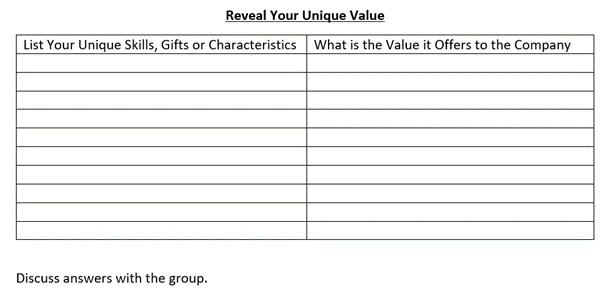

Course Manual 10: Adopting Value
Now that we’re clear on our unique value, it is important to know how to best utilize our unique value and adopt it in the workplace. In this lesson, we will explore our past experiences that allowed us to use our gifts. We will also address key areas such as Role on a Team, Key indicators, Learning Style, Social Orientation, Relationship Patterns, and End Goals and how your unique value can be properly utilized in each area.
Our gifts and talents translate into activities and jobs that help us find fulfillment.
We are now going to go through a powerful 3 Step Process – to help identify what you like to do and what you do well.
Step 1: Using Stories to Identify Applying Our Gifts
Our Stories:

The first step to discovering times you have used your unique gifts and strengths. Look back at stories form your own life of times you did something well or enjoyed doing it. Be sure to look at stories from your younger years, early adulthood, and later adult years. Choose 3-5 stories. Write down specifically what you did, how it made you feel and why you enjoyed it.
Analyze Our Stories:
Next, evaluate these stories and come up with conclusions about your specific unique gifts.
Step 2: Consider the Following Questions in these Key Areas
Role on a Team
Examine whether you completed these enjoyable activities alone or with company in each case. How did you feel about being a part of a team? Do you prefer to work alone? In a team, what role do you play? Were you a team member or participant, a key contributor, a leading key contributor, or a team leader? What was your leadership style like? Were you more of an influencer, a motivator, a delegate, a visionary, or a project manager? Do you prefer to be picked for leadership or do you prefer to be chosen?
Key Motivators
What motivates you? What challenges or triggers do you face? What’s the first thing that comes to mind when you start your car? Risk and adventure, projects, solving difficulties with objects or people, excelling in specific areas, or just finishing a job are all possibilities.
Learning Style
What is your learning style? Do you enjoy reading, listening to podcasts, watching videos, learning by doing, or discussing ideas with others? Which of your five senses, if any, is the most dominant? Do you prefer to master knowledge, talents, or a combination of the two? What topics pique your interest on a regular basis? What are your most valuable assets for achieving your objectives? Which one or ones stand out the most?
End Goals
What are the objectives and purposes to which you aspire as you reflect on your life stories? How important is it, for example, for others to recognize or respond to what you do?
Social Orientation
What criteria would you use to evaluate your desire to collaborate with people, things, or ideas? On a scale of 1 to 100, rate your desires.
Relational Patterns
Do you have an intense or extensive desire when it comes to relationships? Extensive relationships are those with a large number of people but little depth, whereas intensive relationships are those with a smaller number of people but greater depth. Do you fall somewhere in the middle?
Step 3: Get Feedback from a Trusted Friend or Advisor
After you’ve finished these exercises, go over your summaries again and try to spot and write down any trends you notice. Allow a trustworthy friend or mentor to ask you questions about the stories and to share their observations with you. It would be beneficial for them to look through the entire list before going over each story with you one by one. Make a mental note of what they say.
One of the stories will occasionally jump out and connect several of your motivations. For example, there was a woman with who enjoyed playing powder-puff football. Offensive guard was her preferred position. She mostly desired to block for the quarterback and running backs, allowing them to flourish. The rest of her stories fall within this category. She enjoyed working as a support or administrative assistant to a boss she admired. She desired to serve in order for her employer to shine.
Another woman enjoyed being center midfield on her soccer team. She played both defense and offense running the field, giving verbal instruction to other players as to where they ought to be and giving passes to the forwards so that they could score. She loved the diversity that playing both defense and offense gave her. Her leadership in college had all these characteristics—being involved in all aspects of a project in the center of things and delegating and helping others succeed.
Sports are often a great example and good metaphor for how we work well. You can also consider clubs, community service events, group projects or mission trips you have participated in.

Defining Your Workplace Strengths
“Character is the part of your personality that other people tend to admire, respect, and cherish,” say Ryan Niemiec & Robert McGrath (2019), researchers in the field of character strengths.
Strengths like this are the foundations of who we are. And when we use them to express ourselves (both in words and deeds), we feel happier, more connected, and more productive in our work.
They are important to who we are and how we think of ourselves, unlike our interests, passions, and abilities.
It’s important to note that we cannot be great at everything with strengths come weaknesses.
Character strengths, according to the widely used Values in Action Inventory (VIA), are pathways to bigger categories known as virtues that remain across time and cultures (Niemiec & McGrath, 2019).
The 24 VIA central character strengths, grouped into six virtues, are shown in the table below (modified from Miglianico, Dubreuil, Miquelon, Bakker, & Martin-Krumm, 2019):
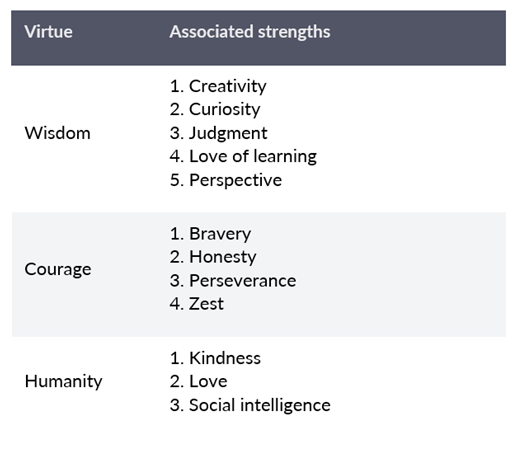
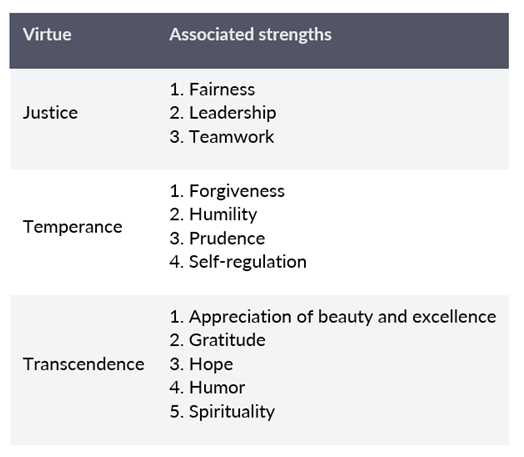
Three-to-seven of the 24-character qualities, referred to as signature strengths, best describe us (Pang & Ruch, 2019).
Do my strengths, truly matter?
Yes, of course.
Character qualities have been identified as critical in our daily lives and beyond, according to recent research from the University of Zurich. They have an impact on the following in the workplace (Pang & Ruch, 2019):
• Employee Health and Happiness
• Productivity in the workplace
• Employee turnover.
• Workplace happiness
It turns out that the order in which we rank our character strengths has a substantial impact on our life.
When someone has a lot of ‘zest’ (a virtue related to courage), they are more likely to regard their work as a calling rather than a way to get money. They have high job satisfaction, take fewer sick days, and are hesitant to resign in the proper position.
We are revitalized and thrilled about what we are doing when we demonstrate our signature strengths; we are passionate rather than apathetic and fatigued.
Indeed, the more signature strengths we employ at work, the better the experience will be (Harzer & Ruch, 2016).
Are they set in stone?
Character qualities are not fixed; they might shift over time.
This provides us with an opportunity (Miglianico et al., 2019).
Thankfully, we are not all alike. If we were, the world would be a less rich place.
The human species has persisted as a result of our personality characteristics, according to evolutionary psychology (Buss, 2009). After all, dealing with unique and often extreme situations necessitates a diverse set of skills, knowledge, and abilities.
It’s good to be unique.
Despite this, most organizations believe that we should focus on improving our weaknesses while ignoring our strengths. Instead, businesses should ask themselves, “Are we utilizing our employees’ strengths?”
This strategy is essentially incorrect unless you want all of your employees to have the same abilities and address the same difficulties in the same way.
Staff members must be provided opportunity to put their natural abilities to good use. Work that is a good match for them will energize and empower them while also enhancing their productivity.
Looking at the bright side
Knowing our character strengths allows us to see the good in ourselves and others and shift our focus away from the problems (Niemiec & McGrath, 2019).
“What makes a child gifted and talented may not always be good grades in school, but a different way of looking at the world and learning.”- Chuck Grassley
Indeed, enhancing our strengths has a significant impact. It not only boosts happiness and purpose in our lives, but it also boosts wellbeing, engagement, and productivity. Employees are more productive and less absent, and the workplace has greater flow, passion, engagement, vitality, employee satisfaction, and dedication (Miglianico et al., 2019).

3 Real World Examples:
Kindness
October Books, a community-run bookstore in Southampton, UK, had to relocate 150 meters down the street in 2018.
The new location was partly supported by local investors, with the bottom level providing long-term housing for persons facing homelessness.
The popular but cash-strapped bookstore required a way to move tens of thousands of books the short distance to its new site. Following a request for assistance, 250 people showed up to form a human chain to transport the books to their new location.
Community support and kindness can go a long way and aid in unexpected circumstances.
Creativity
Chade-Meng Tan, Google’s 107th Creativity Employee, left the company to start the Search Inside Yourself Leadership Institute.
His purpose was to promote a message of happiness, meditation, and serenity around the world after helping numerous Googlers discover inner peace and free their minds of tension.
To create a difference in people’s life, Chade-Meng has ingeniously transformed mindful-based tradition into a commercial and personal-development program.
Leadership
LEGO, the well-known children’s toymaker, was in trouble in 2004. In a world wherever-evolving technology and superhero franchises were at the top of most people’s Christmas lists, it had become obsolete. Jrgen Vig Knudstorp took over as CEO in October of that year, changing the company’s culture and embarking on a new adventure that has resulted in profits increasing by more than 40%.
Since then, the business has created LEGO kits for Star Wars, Toy Story, and Pirates of the Caribbean, as well as a succession of popular films featuring LEGO characters.
The company has been transformed into something with a future thanks to excellent leadership and aggressive improvements.
(There are many Strength Tests options that are offered. More information on 3 of the Top Tests will be provided in the Resource section of this workshop.)
“Genius is the gold in the mine; talent is the miner that works and brings it out.” – Marguerite Blessington.
Our gifts can be applied in many different jobs or roles within an organization. Environment is just as important. So, make sure you are seeking an environment that is in alignment with your values.
It’s crucial to keep in mind that your gifts and talents will develop and become more apparent with time and additional life experience will, in most situations, aid in sharpening your awareness of your strengths and talents.

Exercise 1:15: 3 Step Process – to help identify what you like to do and what you do well.
Have each of the participants answer each of the questions in the 3 Step Process above.
Share with the group.

Course Manual 11: Stand Powerfully
When you hear the word “power,” do you think of control over other people, or money, or even forcefully influencing the course of events? That is one dictatorial definition of power, but there is another: the ability to act in an effective manner. There’s the power of speech, for example, or the ability to ask for what you want, or the simple ability to say no to what you don’t want and yes to what you do. So, what does it mean to stand in your power? It implies that you value what is most essential to you. It indicates that you are aware of who you are, what you are capable of, and why you make the choices you do. Nothing can shake the foundation of who you are or rock your boat. In this lesson, you will discover ways that you can confidently stand in your power as a professional capable woman.
It’s inevitable that from time to time we will be confronted with folks who disagree with us and dispute our beliefs. In these times, we must assert our authority and defend our convictions; this is unavoidable. We are the architects of our own worlds, and what works for you may not work for everyone you encounter along the path. We will now go through a process to help you to stand in your power and take control of your life by accepting responsibility for it.
Living your life from a position of personal power may appear to be an overused phrase designed to persuade individuals to adopt a win-at-all-costs mentality. It’s truly about standing in the truth of who we are as human beings. It’s a way of life in which you show kindness, acceptance, and love to yourself and others.
Standing in our power resembles a soft strength that thrives without being seen or heard. We are fueled from inside when we live life from a place of power. When we offer ourselves the gift of living our truth, we are able to:
a) We stop relying on others to tell us who we are or aren’t.
b) We stop wasting our time worrying about what other people think of us.
c) We appreciate ourselves in a true way, which makes it easier to perceive the good in others.
Taking Responsibility
Being challenged is a positive thing because as we begin to move into our actual selves and a more fifth-dimensional state of being, we will begin to attract that which should be in our life and that which should not begin to feel threatened by the shift, which is where arguments arise. When this happens, staying in your power is critical, because no one else’s opinion should have any bearing on your own. It’s all too easy to sit back and blame others for your problems, or to go along with what everyone else is doing just because “everyone else is doing it.”
We will begin to take responsibility for what is happening in our lives once we begin to open our eyes and see the truth. That is our strength, and no one can take it away from us, or dominate us. We have the ability to create our own reality since you we are the creator. When we start pointing fingers, we are relinquishing all control. However, if we accept responsibility for the problems we confront, we may learn from them, and comparable occurrences will no longer affect us as much.
“Accept responsibility for your actions. Be accountable for your results. Take ownership for your mistakes.” Joelle Casteix

Acceptance
Understanding how similar we are leads to deep acceptance. We all suffer in the same way and have the same potential to love. We are all human beings. When we start to feel separated from one another and believe we are better, less than, or different, problems occur.
When people treat us as if we’re less than or unworthy of who we are look at it as a trap they’ve fallen into. Give them some empathy for where they’re trapped, and then we can swiftly remind ourselves that we have the potential to experience the human traits we love and enjoy. How can you enter into love right now if the quality is love? If it’s joy, how can you make it even better right now? If kindness is the goal, how can you be kind to yourself and others?
Acceptance is the most important step on the road to empowerment. We acquire the gift of strength when we accept ourselves regardless of our circumstances. We receive the blessing of having a nice, peaceful experience around people when we accept others regardless of their ideas or differences.

Freedom
Life’s terrain is constantly shifting and changing. It’s easier some days than others to stay in our control and accept what’s in front of us.
Seeing what happens when we literally release ourselves from the story we’re narrating on those difficult days when our inner voice asks us to stray away from our truth and instead be harsh on ourselves or others.
Stop narrating right now if the story is an elaborate tale of all the reasons why you or someone else should be perceived in a negative light! It always feels like a departure from our gentle strength when we cling on to these kinds of destructive stories. On a physical level, the unease that comes with this departure is often felt. This sensation is frequently our first clue that we’re stuck in a story.
When we put ourselves in the driver’s seat of our lives and take command of our narrative from a position of strength, we achieve freedom. We have the option of focusing on the positive aspects of ourselves and others. There are always positive aspects on which we can concentrate. We get to choose whether or not to bring those things to light. We can also avoid focusing on the things that make us unhappy. By developing new stories that feel good and bring us to empowered living, we can break free from the stories that keep us stuck.

Self-Care
It is also our responsibility to look after ourselves. We are the gatekeepers of our own emotions and thoughts. We get to choose whether the actions we conduct help us maintain our power or encourage us to relinquish it.
Many individuals have discovered that practicing self-care on a regular basis has been critical to discovering their inner truth and standing in their power. They feel it is critical to develop a self-care routine that is tailored to your own requirements and easy to maintain during life’s ups and downs.
Self-reflection through writing and journaling, having a small group of trusted confidants, getting enough sleep, exercise, and fun, spending time with your loved ones, limiting screen time, and saying no when you mean no are all important aspects of an empowered self-care routine.
The trick to self-care is to be sure to add things that make sense to you, one at a time. This isn’t a life overhaul or a bootcamp; it’s a practice of forming happy healthy habits that will help you live your greatest life.
Another crucial factor to consider is whether or not you can commit to doing something on a regular basis so that it becomes routine. Self-care isn’t simply something we do to feel better in our lives; it’s a way of life. It’s a tool we can use to assist ourselves in staying on our path, staying true to ourselves, and standing in our power when we face various challenges.

9 Steps to Stand in Our Power
1.) Choose Yourself First
Whether at work or in our personal lives many folks are eager to get some of our assistance. They see the brightness in our eyes and want a piece of it for themselves.
We are excellent advisors who understand how to supply the key to others’ assistance. It’s important to keep our eyes open; we can’t aid others if we’re not feeling good. It essentially means that we give away what we don’t have.
First and foremost, we must love ourselves, heal ourselves, and feel good about ourselves before moving on to helping others. However, if you we’re in a good place but are low on energy, we should be careful and avoid those who are only looking for our help or attention, as this will not offer us with any lasting energy.
2.) Never Waiver in Your Truth
Sticking to our own truth is an excellent second thing that is essential. There are a lot of individuals in this world, and we all have various perspectives, experiences, and perspectives.
Does this imply that anyone is wrong? No, that’s the whole point; there’s no such thing as right or wrong. For you, there is only right and wrong.
This is the boundary we set for ourselves. Which of the viewpoints do we want to consider, and with which do we agree? And which of the viewpoints does not correspond to our reality?
You’ve come to learn and discover what you believe to be true. What are your areas of interest? What makes you happy in your life? No one can stop you from doing what you love if you stick to it.
Consider this: we admire and look up to those who have discovered their real calling. “They are so confident in themselves,” I wish I could be like that… You have the ability to be! Simply do what you enjoy and live what motivates you.
3.) Set Boundaries for Yourself
Many women are generous and compassionate people. They have so much love to give, yet they don’t get much in return.
The key is to put limits on how much we give away. We should not expect anything in return for anything we give to others.
Giving implies that we are not expecting anything in return. Asking for something in return is an example of exchange, which could be viewed as labor.
As a result, it’s time for you to decide how much you want to give to others without expecting anything in return.
It’s not about being inconsiderate. Life is full of lessons, and it’s important to learn from them and then share what we’ve learned. Now is the time for you to take the next step in asserting your authority. You’re most likely ready as well!
4.) Be the Leader in Your Own Life
There are numerous tasks that we “must” complete. The so-called “life obligations.” We all have them.
It’s past time for us to take charge of our own destiny. People will constantly try to persuade us to do something we don’t like, no matter our age or where we are in life.
It may be our parents telling us to change our career, our friends telling us to go out when you don’t want to, or our spouse telling us to stay at home all day.
It literally applies to everyone! But keep in mind that those who are attempting to dominate our lives have lost control of their own. They simply don’t know where to look for themselves or where to begin, so focusing on other people is a better option.
The intent is to clarified things – knowing it’s not meant with malice; rather, it stems from their own lack of purpose in life. It’s important to remind ourselves to stay in control of our own destiny, to do what we love, and to ignore what others have to say about it.
We were all born with unique abilities, and there is no way to compare ourselves to others. We may all benefit from each other’s experiences, yet we are all unique in our own ways.
5.) Understand the Seasons of Life
Life is cyclical. We are frequently get caught up in life’s seasons. People come and go, and we must recognize that everyone who enters our lives serves a purpose. They are all reflections of ourselves; whether we like it or not, they are all reflections of ourselves.
All kinds of relationships exist to teach you something about yourself. The universe will separate you and it will flow organically once you have learned your lessons regarding this particular connection.
Leaving a situation behind may be both sad and painful. Some of us become engrossed in the same issue over and over again, utterly forgetting to live in the present. How can you expect fresh prospects in your life if you keep clinging to the past?
When we’re in the same down period for a long time, we are not in control. Sadness is very natural and should be accepted as such. After a period of sadness, there is a period of recuperation during which we lay the foundations to be open to new experiences in life.
You don’t have to remember any of the seasons because they are all amazing in their own right, or not so much.
It’s not about forgetting; it’s about making room for new experiences to come into your life. Life is a never-ending school, and how you deal with it is entirely up to you. Astrology is a fantastic approach to understand more about yourself.
6.) Stop Comparing Yourself to Others
When we are constantly comparing ourselves to others, we will always feel inferior. Even though we have no idea what goes on behind closed doors, there will always be someone who is better than us or has more than we do.
Everything we see from the outside could be an illusion. What is no big deal for others could be everything for you.
7.) Avoid Negativity As Much As Possible
We can’t keep people entertained and pleased all day. However, we have the option of choosing who we want to spend time with.
There are a lot of people who lack these positive vibes and would love to hang out with us if we are vibrating at the proper frequency. In order to keep you close to them, they’ll try to make you feel guilty about everything.
We are the source of our own nourishment. People like this are commonly referred to as “energy vampires,” let’s come from a different perspective and say they aren’t on the right track yet.
To maintain our politeness, we must not answer too quickly and keep our distance. After a while, they’ll get it and move on to the next positive individual.
The preceding steps have already demonstrated that we are in charge of our life and that we can pick the energy we wish to be in. Just be careful, and you’ll will succeed!
8.) Be Aware of Yourself
We’ve talked a lot about the environment and external forces, but it’s also vital to be aware of ourselves because everything we do begins with us. You can ask yourself, was I actually following my own path? Is it possible that I stepped out of line this time?
Are you capable of apologizing? We are far from perfect, and we all make errors. It is sometimes necessary for us to apologize. If anything in our life does not feel right, our body will let us know.
You will be aware that something isn’t quite right, and it’s up to you to figure out how to fix it.
A vulnerable soul is a powerful soul. The warrior is not the one who fights on the outside; rather, the warrior is the one who fights on the inside of ourselves.
Consider what strength is: it’s the calm storm that comes in and embraces everything; it’s the person who grins even when you’re not in sync with yourself.
It’s the individual who understands that everyone is doing things at their own pace and that we’re all in the same boat, trying to figure out life’s lessons.
There is no such thing as a flawless human being, yet a strong one can be identified by their transparency (no secrets), endurance, willingness, and friendliness. A strong individual is kind and sympathetic yet, knows how to follow his or her own path.
9.) Trust Your Inner Power or Intuition
The inner knowing that everything will be well again is known as inner power or intuition. It’s a sense of knowing that what we desire to do will happen. It is understanding that everything we put into the universe via hard work will be returned tenfold.
Sitting at home and doing nothing will not get us what we want. Rather, we must choose something we enjoy and do something about it. Money, recognition, inspirations, and like-minded people will only cross your path if you are on track to attain your goals.
Our life will feel pointless if we don’t have any ambitions or goals, and our inner power will remain dormant. Get out there and see what life has in store for you. Do not cling to the past or the future; instead, live in the now and decide what you want to do today.
Listen to your intuition, your inner knowing, and you’ll arrive at the exact location where you’re supposed to be!
It’s important to always assess and ask yourself – What can I do to make myself as happy as possible? What changes do I need to make in order to get what I really want? Begin with inquiries and work your way to your own unique life path. Yes, you’ll be able to do it! All you have to do is trust in yourself.

Exercise 1:16: Self Inquiry
Have each participant answer the following questions:
What can I do to make myself as happy as possible?
What changes do I need to make in order to get what I really want?
Share answers with the group.

Course Manual 12: Your Potential
In this last lesson, we will discover the exact steps to take to live up to our true potential. Do you anticipate there will be more obstacles in life and continue on your path with your head down, dreading failure? Do you let one person’s negativity affect your attitude when an unhappy customer takes out his or her aggravation on you? Do you carry the rejections into your next sales pitch when the “noes” outnumber the “yeses” in sales? If you responded yes to these questions, you risk not only suffocating your intrinsic potential, but also never discovering who you truly are or what you can become. It’s all too easy to allow life’s difficulties sap your energy, deplete your motivation, and give you a pessimistic attitude, but there is a method to keep challenging situations and negative ideas from getting in the way of your success and pleasure.
“The big challenge is to become all that you have the possibility of becoming. You cannot believe what it does to the human spirit to maximize your human potential and stretch yourself to the limit.” Jim Rohn
Life is full of unexpected twists and turns. It may appear that all of your efforts to succeed have been in vain at times. Sales may falter, relationships may break down, and obstacles may develop, making the silver lining difficult to perceive. But, as long as you have a good base to return to and build on, everything will be fine. A positive mentality focused on and grateful for the wonderful parts in your life, as well as a commitment to enjoying yourself while pursuing your goals, are the foundations that will take you through the more difficult moments in life.
Our brain has a negativity bias, which means that we are more likely to notice the unpleasant, uninteresting aspects of life than the motivating, positive ones. As a result, it’s critical to make a concerted effort to teach your brain to think more positively in order to achieve your objectives. Every setback becomes another learning opportunity when you have the power of positive thinking on your side. What may have formerly knocked you down can now be used to motivate you to do and be better. Pushing negativity out of your mind and allowing thankfulness and joy in are important steps in cultivating a positive mental attitude that allows you to tap into your latent potential and recognize that there is a solution to every difficulty.
It is necessary to be both optimistic and practical. Recognize that you’ll need to take small steps if you want to transform your life by increasing your drive and taking action on your dreams. The process can be slow, with many setbacks and challenges to overcome, but the appropriate perspective can help you get through it. You may unlock your true potential if you spend time every day retraining your thought process, establishing a real awareness of your thought patterns, both negative and positive, and actively reforming them so that your focus switches to the positive aspects of your life. You’ll be able to overcome any obstacle, experience genuine joy and peace every day, and take steps toward achievement with unwavering faith in yourself and your decisions.

Activating Your True Potential in 8 Easy Steps
Step 1: Assess Your Gifts and Strengths
One or more of your strengths or gifts will almost always be involved in your maximum potential.
(Re-visit lesson 10 for tips on identifying your strengths.)
• What are your gifts and strengths?
• Do you know and acknowledge your true abilities?
With a concentrated approach, most of your strengths can be applied to any activity.
The first step is to figure out what your strengths are. What do you excel at more than almost everyone you know? What has always come naturally to you? What do you excel at?
Step 2: Assess the Areas You Want to Improve or Develop
Knowing what we require assistance with is beneficial. This can be related to wanting to improve our weaknesses.
If at all feasible, attempt to rectify and strengthen these weaknesses, but it’s also beneficial to avoid or delegate them when action is required.
This can also be known as personal development.
Personal development is the process of evaluating your life goals and values while also improving your abilities and attributes in order to achieve your full potential. They can help you grow in maturity, prosperity, and happiness. Many people improve their personal development abilities during the course of their lives in order to better themselves and achieve their objectives. They can do so through education, mentorship, self-help, and other methods.
Personal development skills are characteristics and abilities that aid in personal and professional development. In other words, they are abilities that assist you in fostering your personal growth. Understanding and honing these abilities will enable you to reach your full potential. Self-development or personal growth are terms used to describe this process.
What are the benefits of having personal development skills?
Personal development skills are crucial because they enable you to design strategic and tactical strategies for personal and professional development in order to achieve your objectives. Personal development abilities can be useful to hone so that you can include them into your everyday routines and use them to:
• Obtain personal and professional objectives
• Improve your skills and talents to advance in your career
• Make improvements to oneself.
• Find happiness and fulfillment.
Personal development skills examples:
Personal development skills can be acquired through education and training or might be attributes or abilities that you already possess. Depending on their goals, people will value different personal development abilities, however, here are some examples of skills that people typically use to help them grow:
• Communication
• Interpersonal
• Organization
• Problem-solving
• Self-confidence
• Adaptability
• Integrity
• Work ethic
• Leadership
Personal Development skills in the workplace:
While personal development skills can benefit you in all aspects of your life, the following habits may be particularly beneficial in the job and can help you enhance your career:
Be a good listener. Paying attention to what other people say is an important part of becoming a successful communicator. Focus on comprehending what your coworkers and clients are saying so you can remember it and answer appropriately. From phone conversations to job interviews, use effective and professional listening and communication skills.
Work well with others. You will be a valued team member if you have good people skills. You should be able to motivate and collaborate with others. Build relationships with coworkers, clients, customers, and acquaintances of various types and backgrounds by honing your social skills.
Time, work, and supplies should all be organized. Plan out your duties so that you can get them done fast and easily. If you’re working on multiple projects, know which ones to prioritize. You may be better able to meet deadlines and collaborate effectively with others if you are well-organized.
Work through difficult situations. Assess your alternatives and choose the best approach when dealing with an issue. Know when to seek counsel or conduct study into various scenarios. People who can think critically and solve complicated problems are more likely to make smart decisions in both their personal and professional lives.
Believe in yourself. Others are more inclined to believe in you if you are confident in your decisions. This pleasant energy has the potential to excite and inspire those around you. If you face obstacles with confidence rather than doubt, you will be better able to handle them and achieve your goals.
Adapt to the changing environment. Be adaptable so you can easily deal with changes at work and in your personal life. Adaptable people can operate well alone and in groups, manage several tasks, work in a range of environments, and accept new ideas, among other things. Being able to adapt to change effectively can make these situations less stressful for all parties involved.
Tell the truth. The foundation of a strong relationship with coworkers and bosses is honesty. Maintain a high standard of ethics and adhere to your principles. Respect, satisfaction, and a good reputation at work can all be gained via integrity.
Be dedicated to and passionate about your work. People with a strong work ethic are more productive, dependable, and committed to producing high-quality results. This commitment might assist you in completing projects on schedule and motivating your coworkers.
Lead those around you. Being an effective leader involves self-assurance, foresight, and communication. People who have these leadership skills can assist their team in progressing and becoming more productive without becoming bossy.

Step 3: What makes you happy?
Consider what brings you joy.
Ask yourself the following questions:
– What do you enjoy doing?
– What skills come naturally to you?
– What activities make you lose track of time because you are having fun doing them?
– What are some things you actively desire to do even if you don’t get paid for them?
Step 4: What goal do you want to reach- what do you want to accomplish?
You need to decide what you genuinely want to master now that you know your strengths, weaknesses, and likes.
To put it another way, what do you WANT to do?
Seriously, how serious are you?
You won’t be able to move on and prosper unless you make this critical decision.
Where is your heart guiding you? Use your intuition.
How will you measure your success?
When will you be able to tell if you’ve attained your full potential?
What exactly does that imply to you?
Is it when you make six figures or when you go through the day without losing your cool or exploding in rage?
Is it when you’re able to play a piece of music on the piano?
How will you know when you’ve achieved your objective?
Step 5: Eliminate Distractions
Distractions, as you may have surmised, are the enemy of development.
We all have things we enjoy doing that serve no purpose other than to provide short entertainment (and a distraction from our goals).
Make a list of your favorite ways to pass the time these are typically your distractions.
Ask yourself the following questions:
• Do they provide you with long-term or short-term value?
• Are they preventing you from doing the things you should be doing?
• If that’s the case, how eager are you to avoid these items?
Make a strategy because having fewer distractions indicates your ability to succeed.
Step 6: Seek Guidance from other Successful People
We can’t always realize our full potential without the help of a mentor, coach, advisor, or cheerleader in our corner.
Having a mentor can help you cut years off your learning curve and prevent the mistakes you’re bound to make on your own.
Find the greatest people in your field and contact them.
At the very least, read literature produced by specialists on the subject.
Your personal library can give you with a wealth of mentors who you can call on at any time.
Step 7: Commit to Your Success
Commitment is also required for mastery and success.
It’s the dedication to grow as a person, overcome challenges, be patient and focused, and put in the required effort to achieve your objectives.
It’s the determination to locate a mentor and avoid the tempting distractions that can prevent us from realizing our full potential.
Step 8: Continue to Improve
EACH AND EVERY DAY II AM GETTING BETTER AND BETTER is a powerful mantra to follow.
Sometimes that’s all that’s required – tiny, consistent, and regular advances every day.
The secret to mastery is to make consistent improvement.
Anything might take a long time to master, many years in fact, so be patient!
A word of caution: If striving for perfection is your everyday objective, you will be sadly disappointed. This is due to the fact that perfection does not exist!
Instead, weekly progress is a realistic aim that will keep you moving forward, one step at a time, toward your goal.
So, if you want to reach your full potential, remember that you already have it within you.
We all do, and there’s no better time than now to get started, before it’s too late.
Focusing on these steps will help you guide you on your path.
It will cause you to be more deliberate in how you spend your time.
Yes, you will have to make some sacrifices to achieve your objectives, but most people believe it is worthwhile.
So, what are your ambitions and goals, and how do you plan to achieve them?
It doesn’t matter what it is; you can accomplish it!
There’s no better time than now to get started, before it’s too late.
Only you have the key to unlocking your true potential, so go forth and open some doors!
“The will to win, the desire to succeed. The urge to reach your full potential – these are the keys that will unlock the door to personal excellence.” Confucius
As we proceed on with the next Workshop “Limiting Beliefs,” we will explore how belief system directly impacts our results. Our negative beliefs will keep us playing small, sabotage our success and prevent us from reaching our true potential. We will go through a powerful process to uncover those beliefs and where they come from and then learn how to let them go, so they can be replaced with new empowering beliefs moving forward. See you in the next Workshop!

Exercise 1:17: Creating Your Action Plan to Reaching Your True Potential
Have each participant go through the 8 Steps to Access Your True Potential and answer the questions below.
Then, share your answers with the group.
Step 1: Assess Your Gifts and Strengths
1. Make a list of 10 of your gift sand or strengths.
2. Do you know and acknowledge your true abilities and talents?
Step 2: Assess the Areas You Want to Improve or Develop
What weaknesses would you like to strengthen?
What skills would you like to develop?
Step 3: What Makes You Happy?
Consider what brings you joy.
Ask yourself the following questions:
• What do you enjoy doing?
• What skills come naturally to you?
• What activities make you lose track of time because you are having fun doing them?
• What are some things you actively desire to do even if you don’t get paid for them?
Step 4: What goal do you want to reach- what do you want to accomplish?
Answer the following questions:
• What goal do you want to accomplish?
• Where is your heart guiding you? Use your intuition.
• How will you measure your success?
• When will you be able to tell if you’ve attained your full potential?
• What exactly does that imply to you?
• How will you know when you’ve achieved your objective?
Step 5: Eliminate Distractions
Make a list of your favorite ways to pass the time these are typically your distractions.
Then, Ask yourself the following questions:
• Do they provide you with long-term or short-term value?
• Are they preventing you from doing the things you should be doing?
• If that’s the case, how eager are you to avoid these items?
• What strategy will you put in place to avoid these distractions?
Step 6: Seek Guidance from other Successful People
List 3-5 mentors you would like to connect with or follow.
List 3-5 books you will add to your personal development library for future growth.
Step 7: Commit to Your Success
On a scale from 1-10 – How committed are you to your success?
Step 8: Continue to Improve
Make an action plan to implement the above steps. What days/times will you commit to working on your goals in order to reach your true potential.
Project Studies
Process Review:
It is essential to make the Women Empowerment Program a top priority, committing the time, focus, and dedication required to succeed. The program should have a direct STRATEGIC impact on the future of the organization. The most effective strategy is to connect the Program to the company’s mission, purpose, value proposition, and organizational values.
At its most advanced degree, Women Empowerment is intended to generate an improved culture and equal playing field for women of your company.
What would be the compelling rationale for attracting employees to the Program and satisfying senior management?
Is the Women Empowerment Program supported by the Human Resources Department?
HR is a key player in the decision-making process. Employee engagement is a powerful outcome and basis of the Women’s Empowerment Program, which will play a key role in reducing turnover since it:
• recognizes the value of people
• channels energy into purposeful action
• capitalizes on employees’ joint creative energies
• empowers employees to become more entrepreneurial
• flows ideas and innovation across internal and external boundaries
• maximizes the creation of value while reducing non-value-added work
Is this program compatible with HR’s strategic and operational goals?

Process Re-Design:
Make a plan on you and your team will implement the following strategies you learned in this Course Manual:
1. The results of your Passion Belief Assessment.
2. Creation of Smart Goals.
3. Ignite Your Passion Process.
4. Your Career Plan and Vision Statement.
5. Share success stories you experienced from the workshop.
6. How will you to adapt visualization and creative techniques.
7. How will you implement a plan to commit to investing in yourself.
8. Identify Priorities and Align Values and how to put specific boundaries in place.
9. Share the results of your unique value exercise that is shared amongst the group.
10. Identify what you love and do well. Create a plan to change including a step-by-step action plan to reaching your true potential.
11. Review the resources and case studies provided in this Course that exemplify new practices for personal growth and productivity.
12. Develop new communication practices and collaboration with employees allowing them to effectively use their gifts and skills.

Resources:
More on The Law of Attraction: The Secret by Rhonda Byrne
More on Investing in Yourself: How to Invest in Yourself: 33 Ways to Change Your Life’s Potential
Online Creativity Tools: Online Tool as a Creativity Prompt
There are a number of online resources that act as prompts to spark your creativity:
1. Need an idea for a blog article? Portent’s Content Idea Generator gives creative entrepreneurs title ideas to tweak and make your own.
2. The Idea Lottery from Idea Champions generates random connections between words using a grid format to spark new trains of thought.
3. Creativity Games has a simple random word generator to stimulate lateral thinking.
4. The imagination prompt generator might be useful for stimulating writing ideas in a pinch.
5. Or, if you’re open to random suggestions to solving a tricky problem, try digging into the magic sandbox from Idea Sandbox.
6. The Creativity Pool contains hundreds of unused ideas for products uploaded by creative entrepreneur from all over the world. Some are terrible, but you might find a gem of inspiration between all the rest.
Useful Tools for Assessing/Developing Strengths:
Individual character strengths:
Complete the free online VIA test and generate a ranked list of your character strengths and virtues to understand your cognitive, emotional, social, and community profile.
Team character strengths:
Make use of team reports to combine VIA character strength profiles from multiple team members.
Explore the team from more than one perspective to understand their strengths and the value each member brings.
Read more about the VIA.
Once you have completed the VIA assessment, check out The Power of Character Strengths: Appreciate and Ignite Your Positive Personality by Ryan Niemiec and Robert McGrath (2019), available on Amazon.
Use the Strengths Builder as a way of developing your signature strengths.
Create a life in which you thrive, function at your best, and make the best of opportunities as they arise.
PositivePsychology.com Strengths Resources
We have many resources at PositivePsychology.com that will help you to build your strengths.
Strength journaling provides a way of attending to and exploring your strengths. Use the worksheet provided to celebrate your Positive Qualities.
Learn to focus on your strengths rather than your weaknesses by Identifying Limiting Beliefs About Personal Strengths.
What strengths protect your family? Recognize and grow these strengths using the Family Tree of Strengths worksheet.
Exploring Character Strengths guides you in identifying and reflecting on character strengths.
Finally, the Maximizing Strengths Masterclass© is the ultimate tool in helping yourself and others identify and develop their strengths. This coaching package is just what you need to become a strengths-based practitioner and help clients reach their potential.
17 Strength-Finding Exercises – If you’re looking for more science-based ways to help others develop their strengths, this collection contains 17 strength-finding tools for practitioners. Use them to help others better understand and harness their strengths in life-enhancing ways.
More on Meditation: Beginners Guide to Meditation: Meditation the Complete Guide- Meditation for Beginners, Mindfulness, Happiness and Peace by Katie Anderson
Measuring Success:
Quality metrics are crucial in almost every aspect of life. Management is like sifting fog without distinct metrics, and there will be no consensus of vision, value, methodology, or results. During the early stages of a program, a company should consider what measures should be utilized to determine whether the program met its objectives.
Put together some KPI’s (key performance indicators) to track results of the program. Document results after completing each monthly Workshop.
Program Benefits
Marketing
- Customer experience
- Sales support
- Effective communication
- Positioning power
- Market growth
- Increased ROI
- Increased productivity
- Competitive advantage
- Improved image
- Accelerated growth
- Cutting edge
Management
- Increased collaboration
- Leadership excellence
- Improved communication
- Happier team
- Empowered employees
- Positive environment
- Innovation
- Augmented skills
- Valued skills
- Increased productivity
- Increased engagement
Human resources
- Improved culture
- Happier workplace
- Greater retention
- High-impact teams
- Growth mindset
- Increased engagement
- Improved management
- Leadership excellence
- Improved skills
- Strong Communication
- Empowered employees
Client Telephone Conference (CTC)
If you have any questions or if you would like to arrange a Client Telephone Conference (CTC) to discuss this particular Unique Consulting Service Proposition (UCSP) in more detail, please CLICK HERE.
















